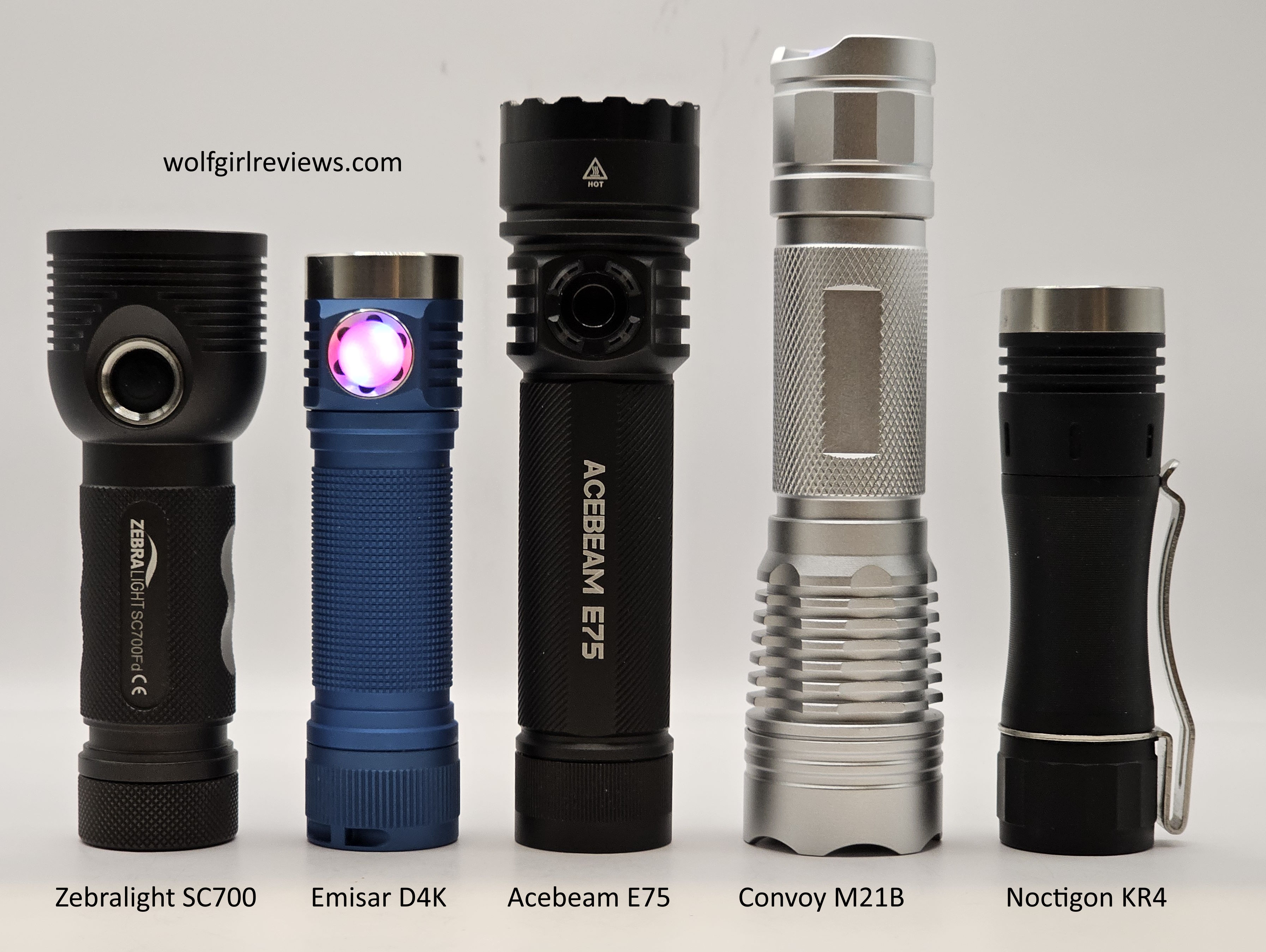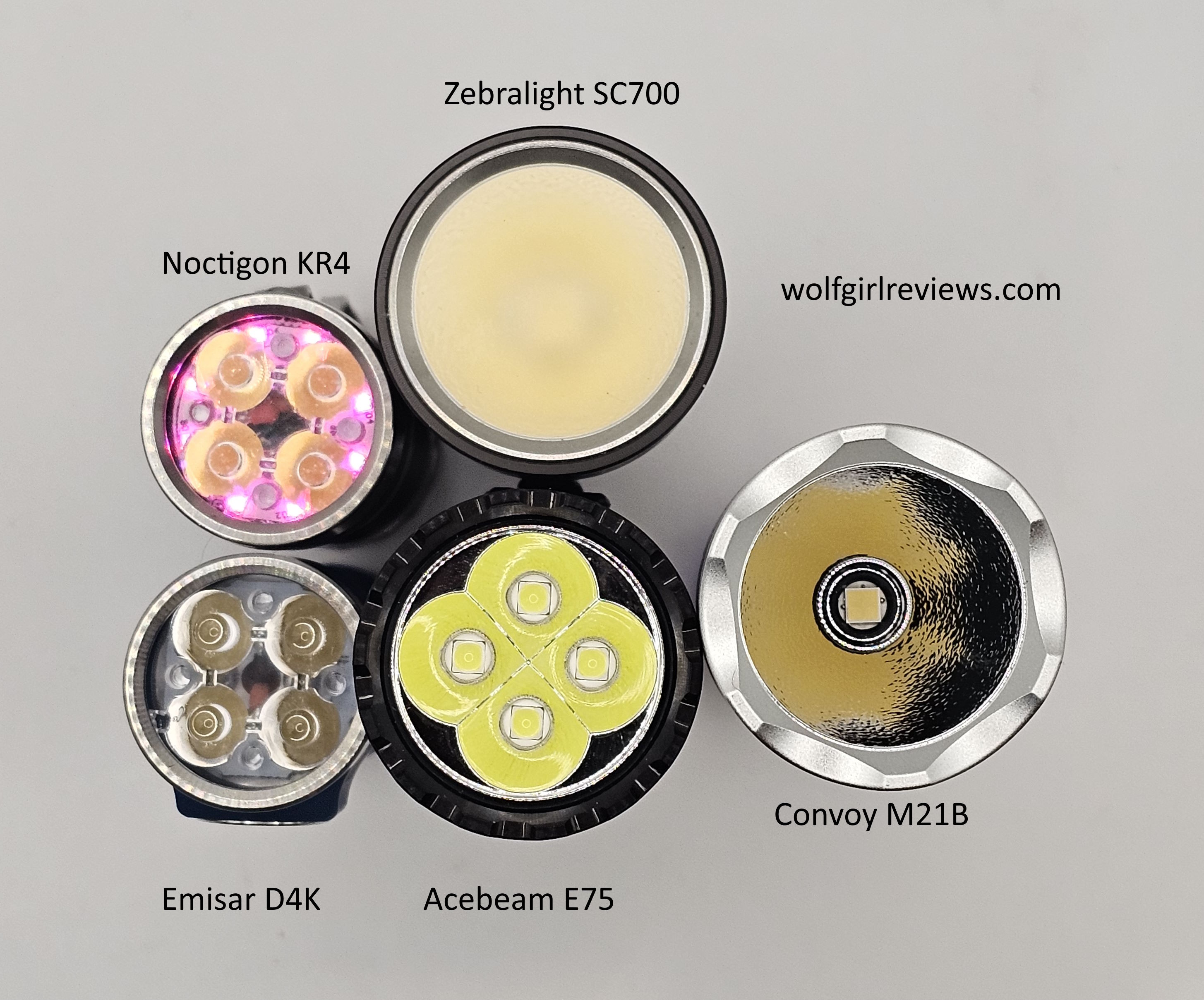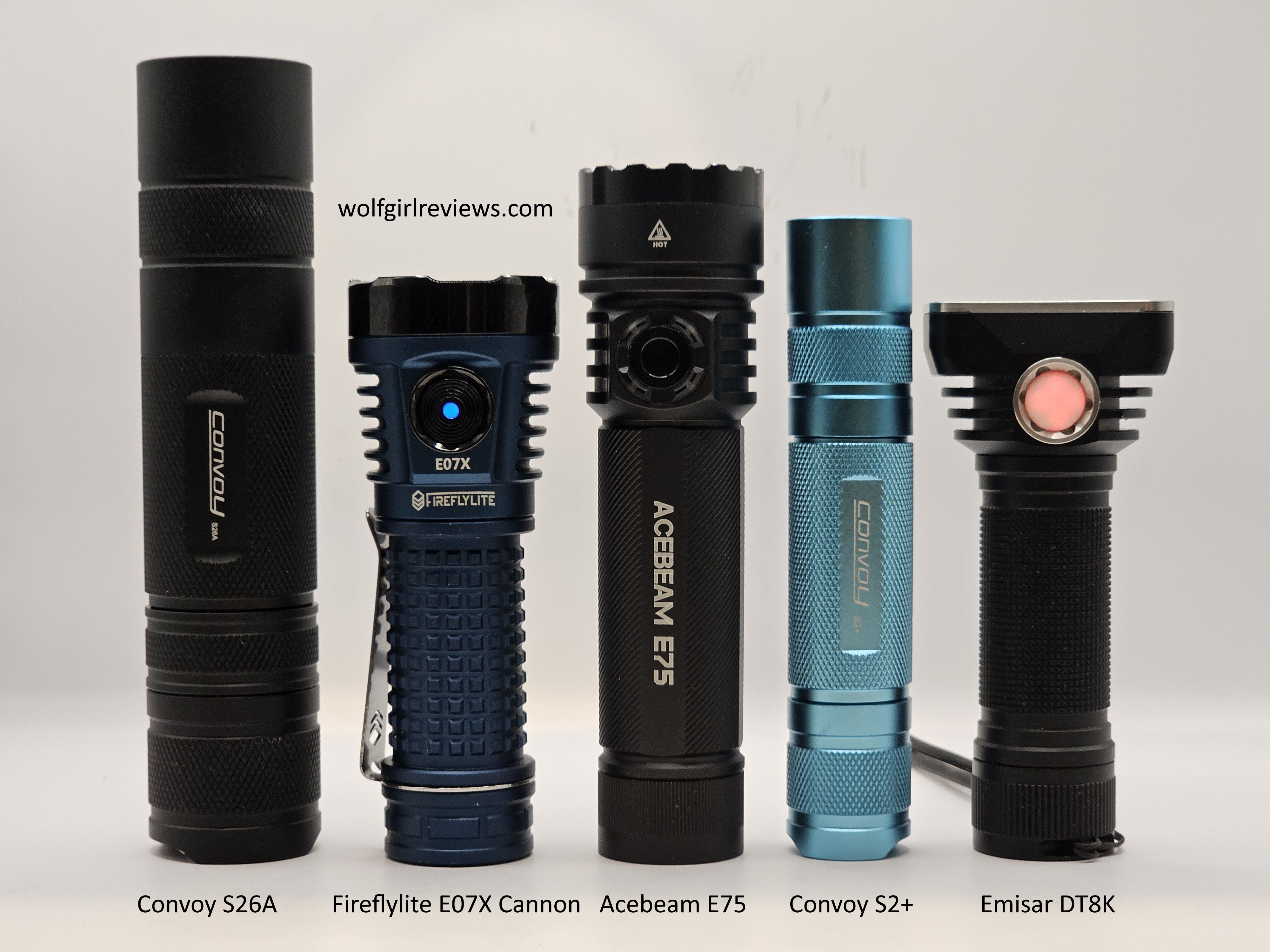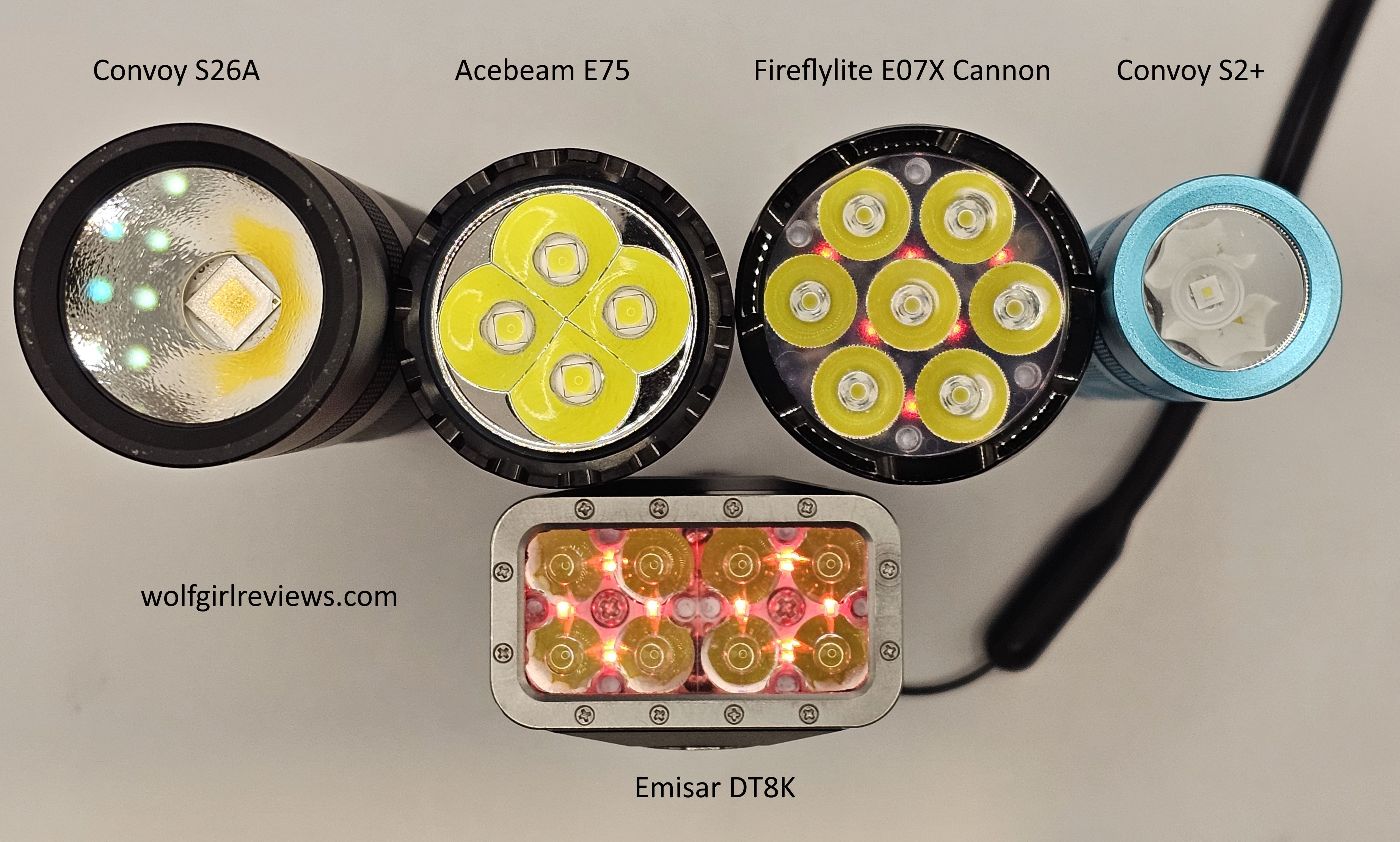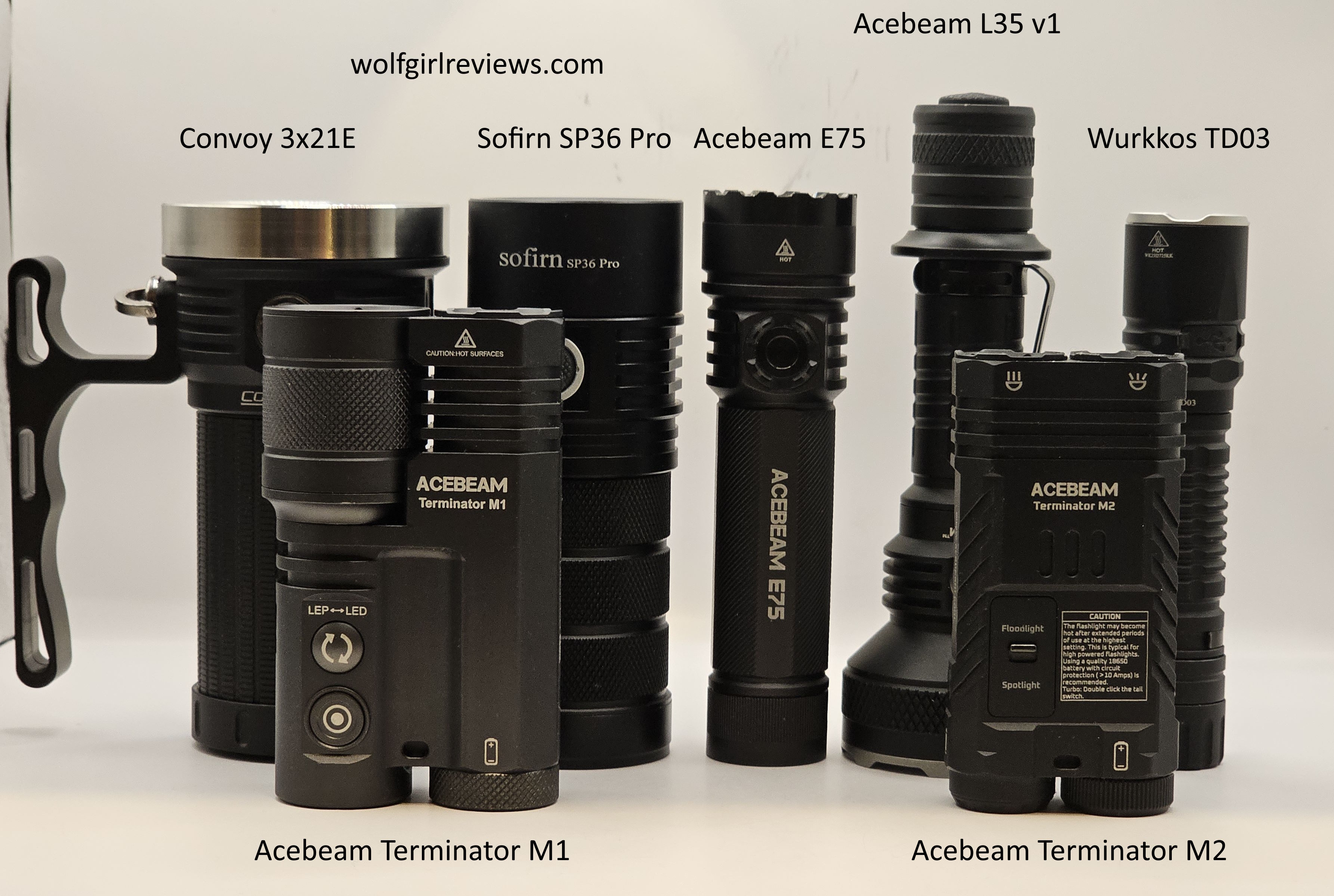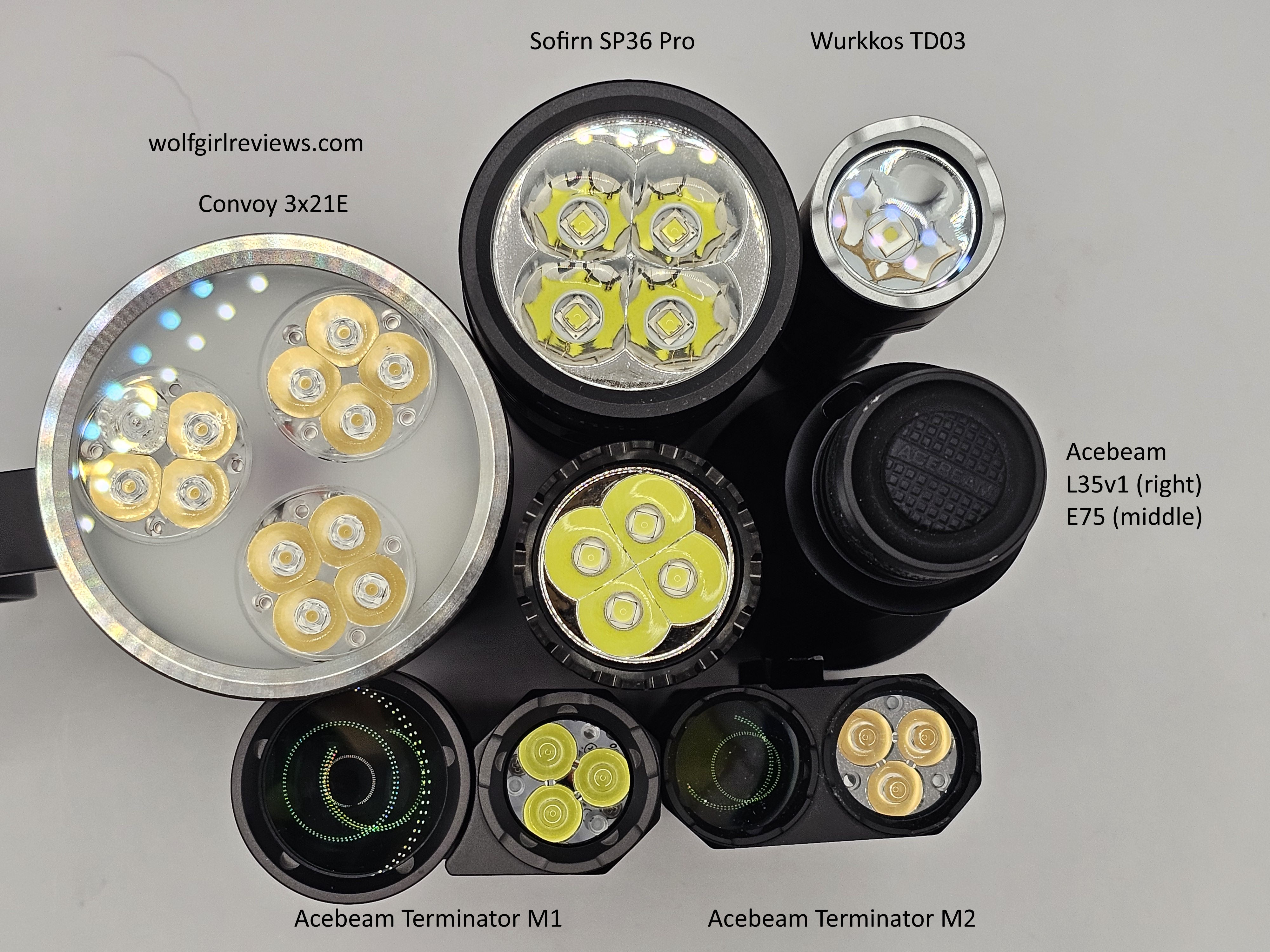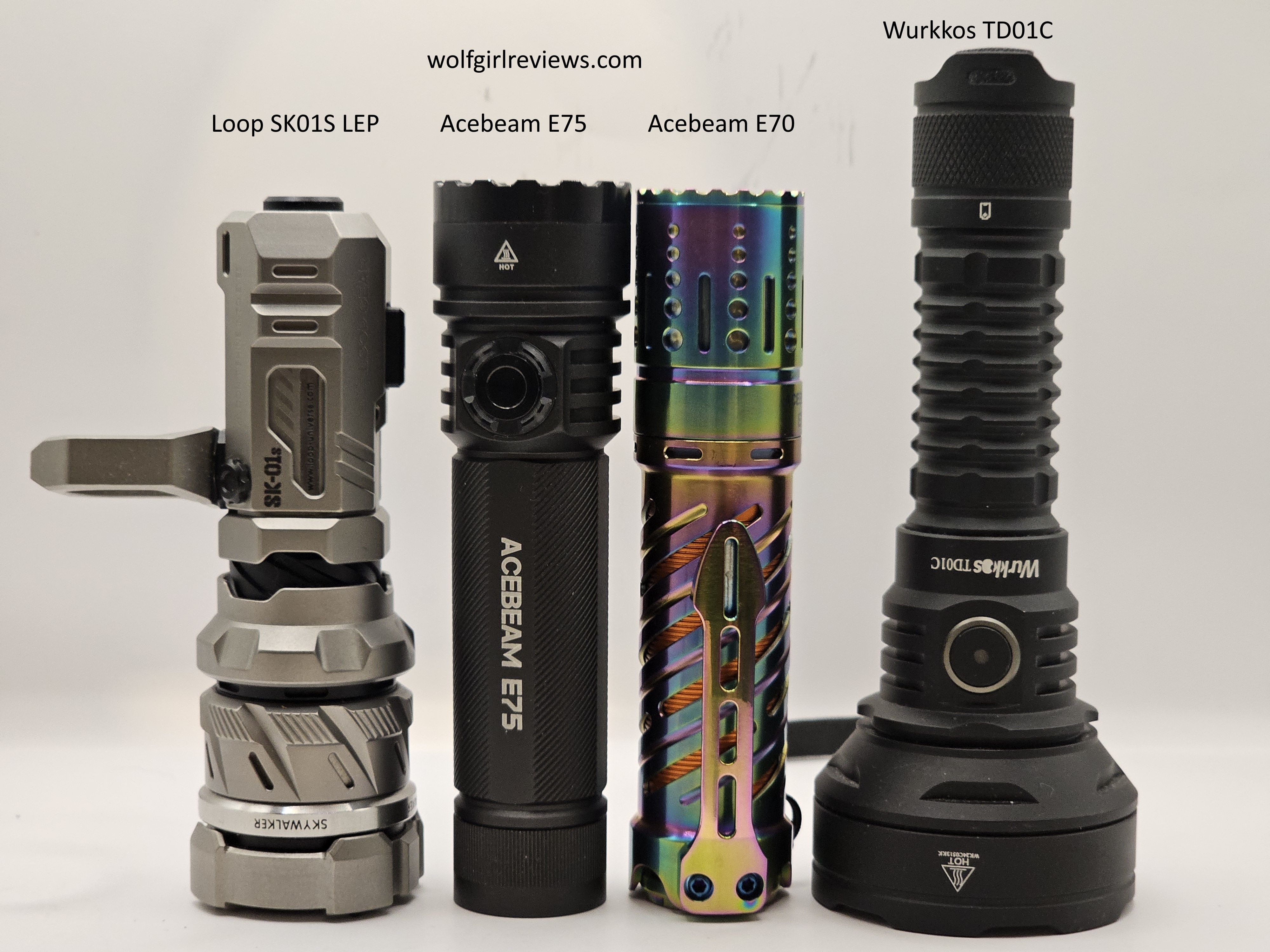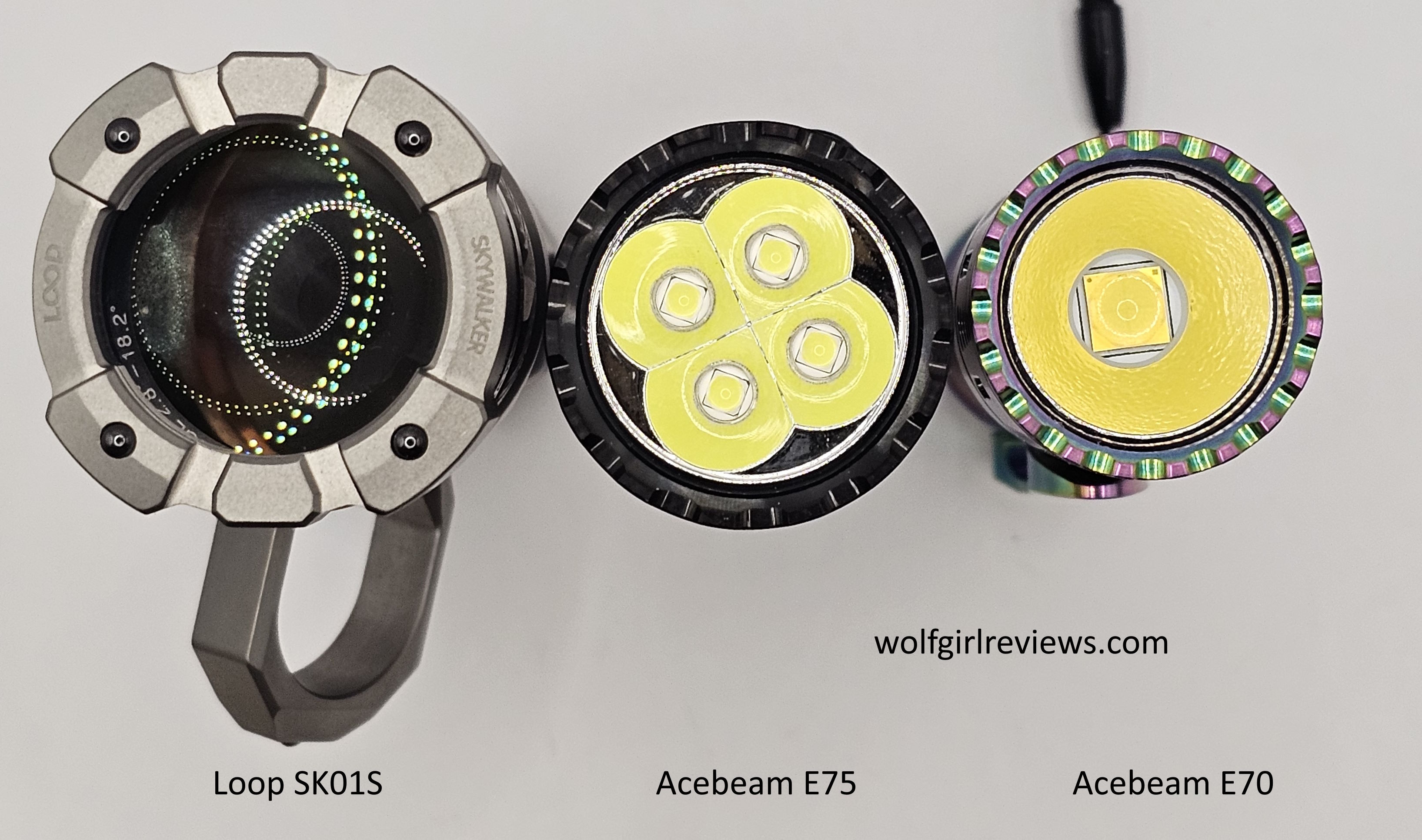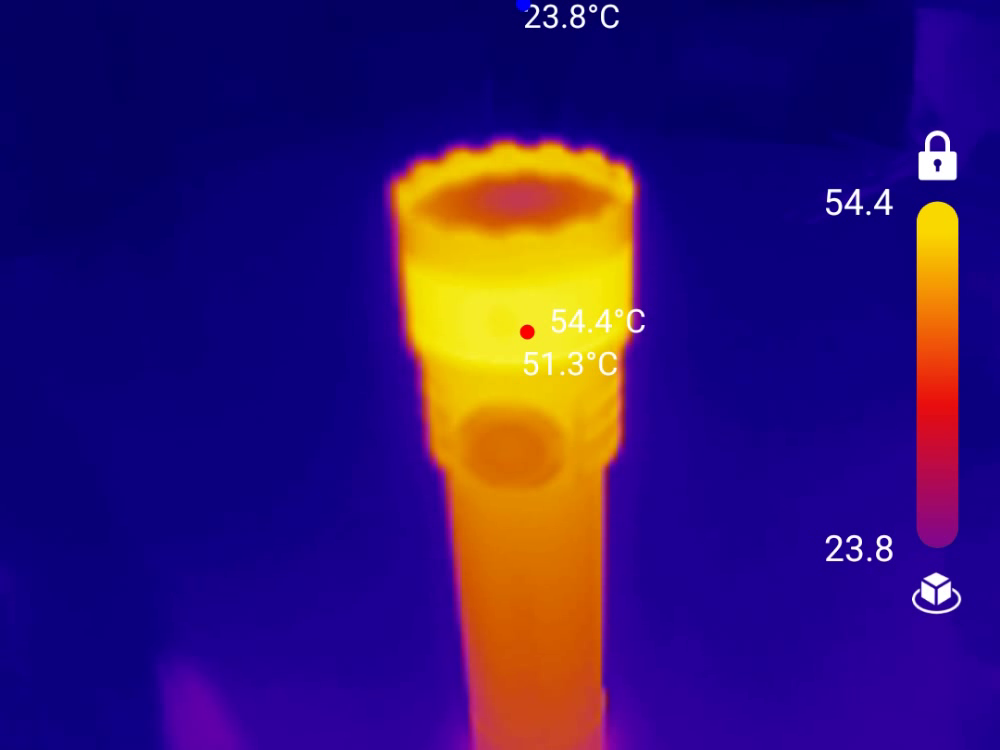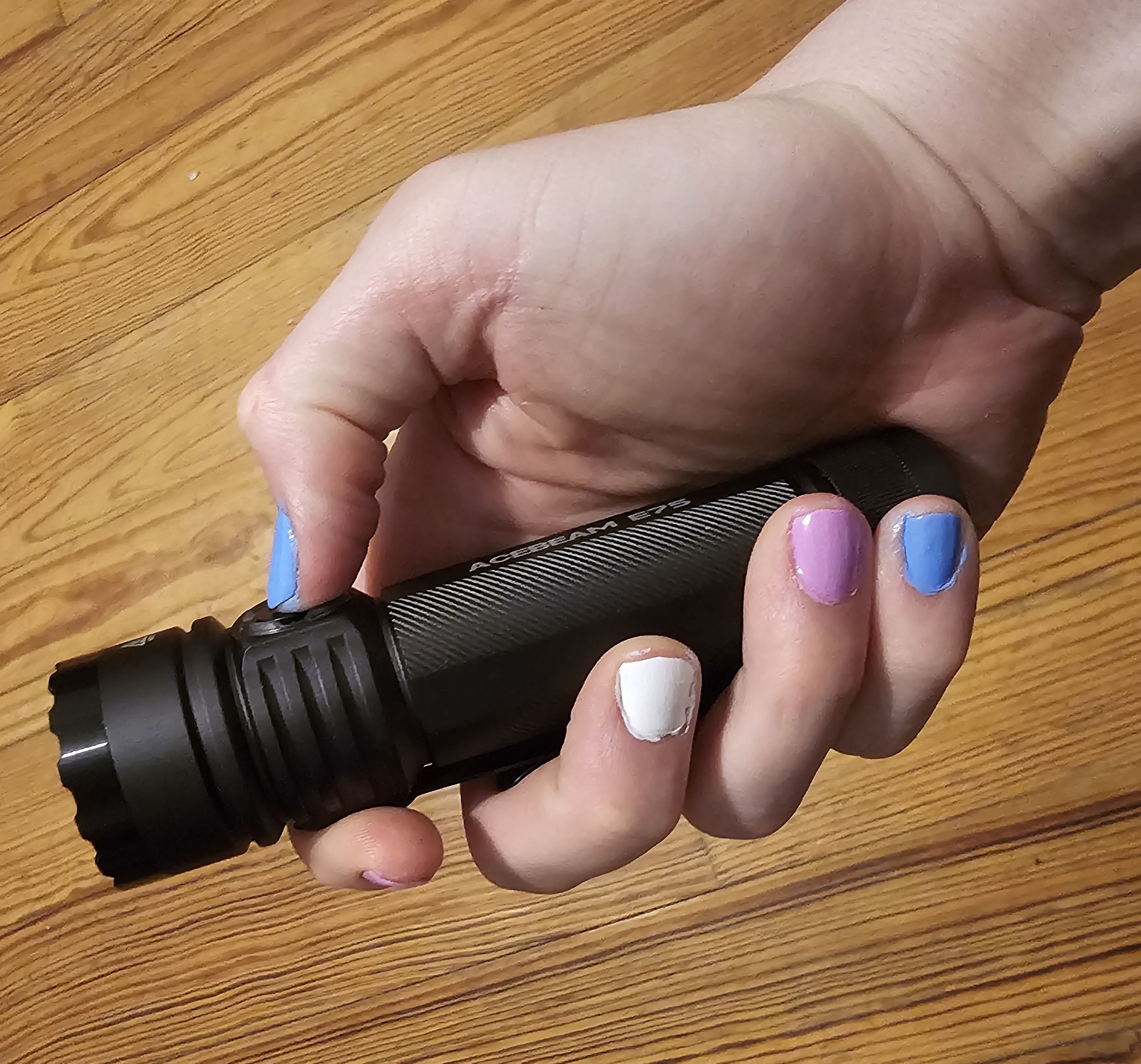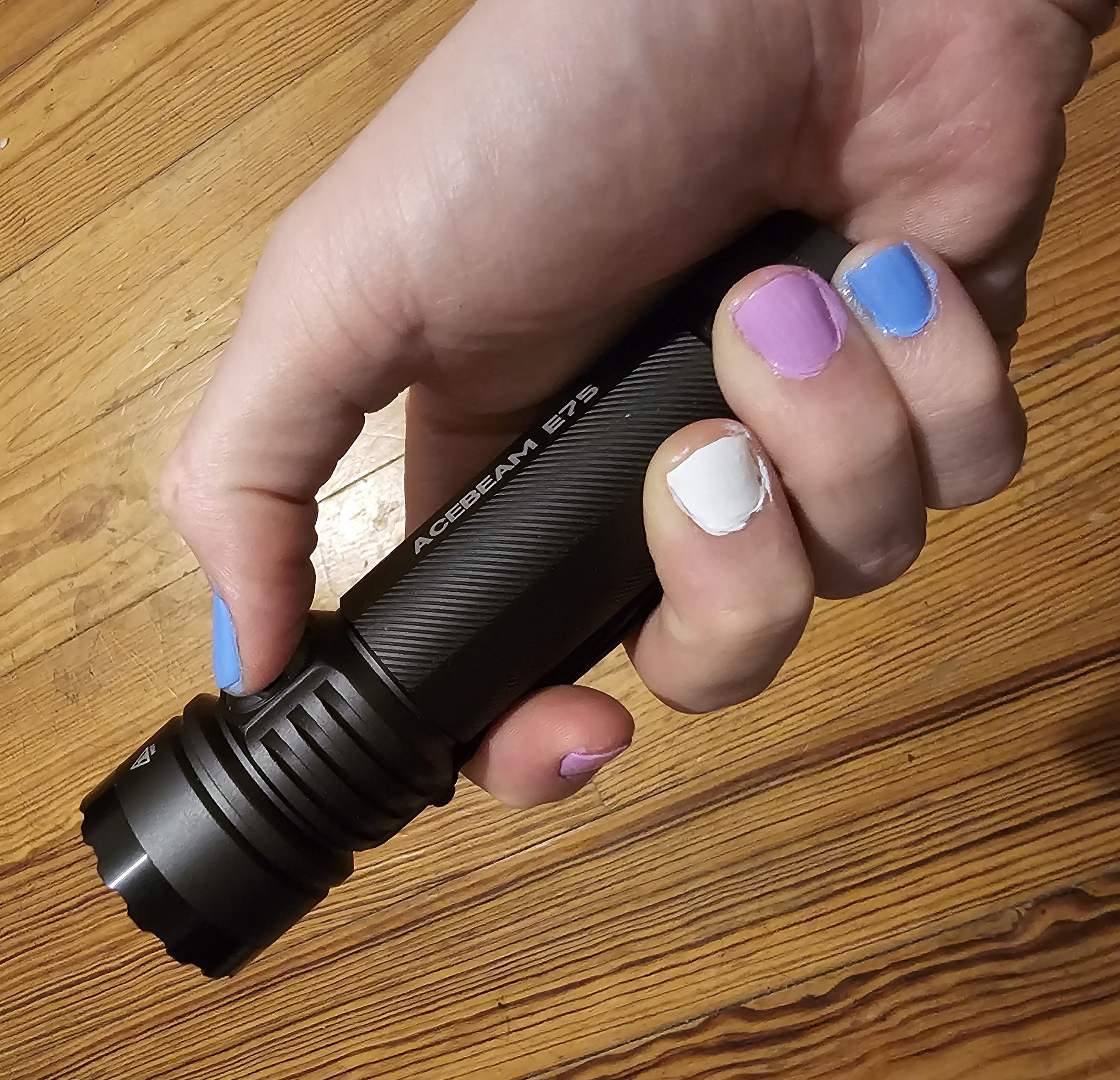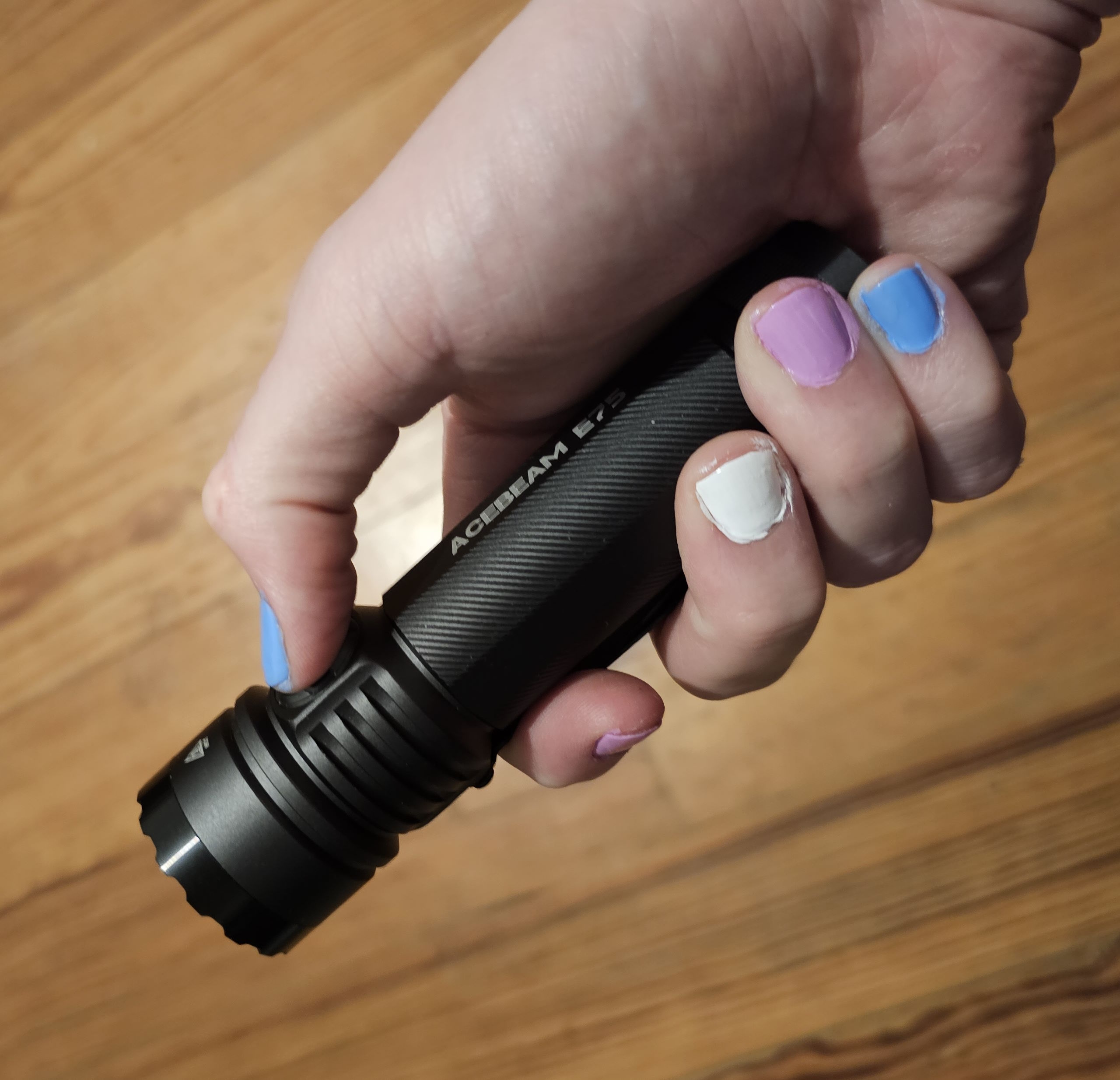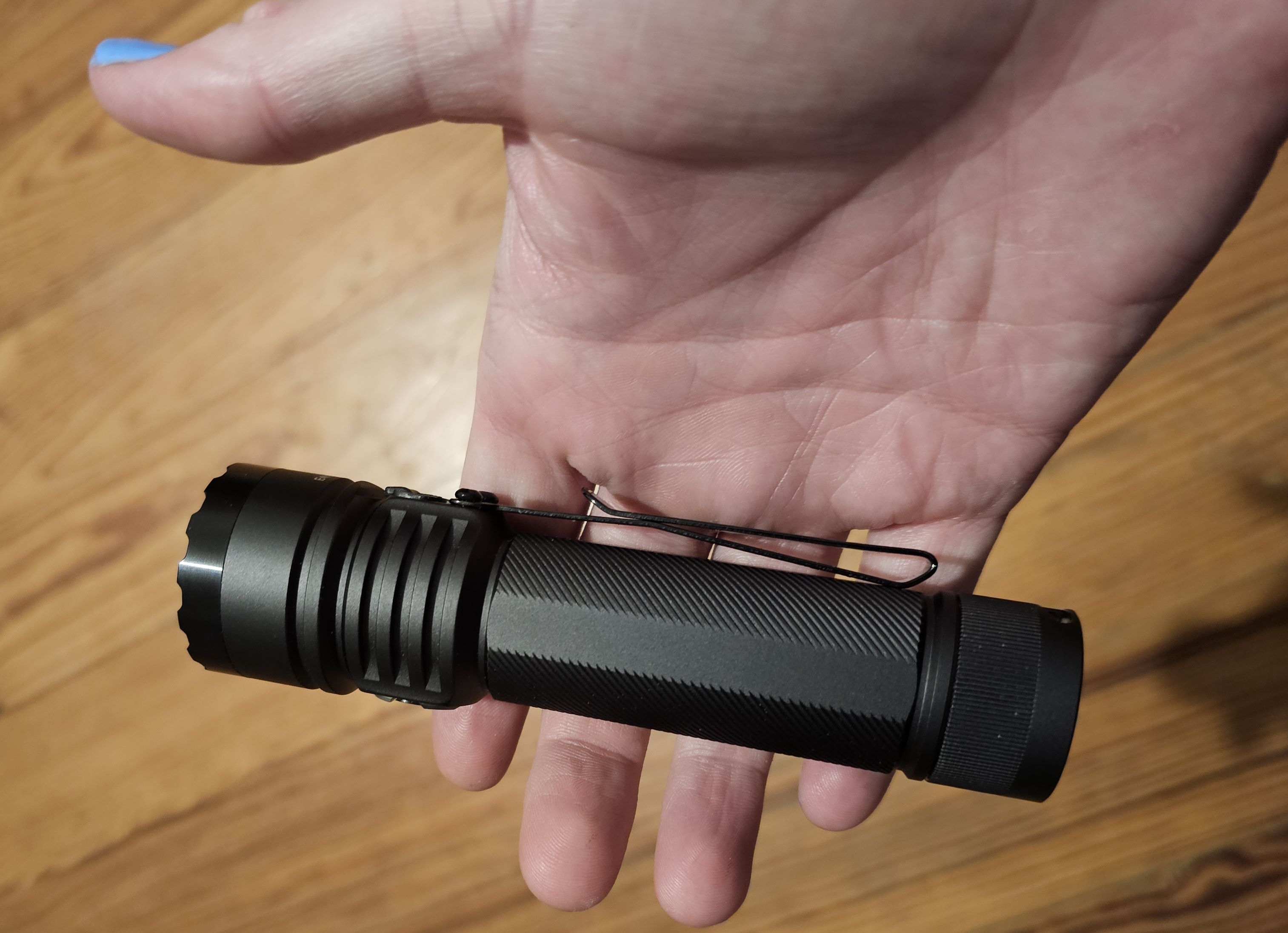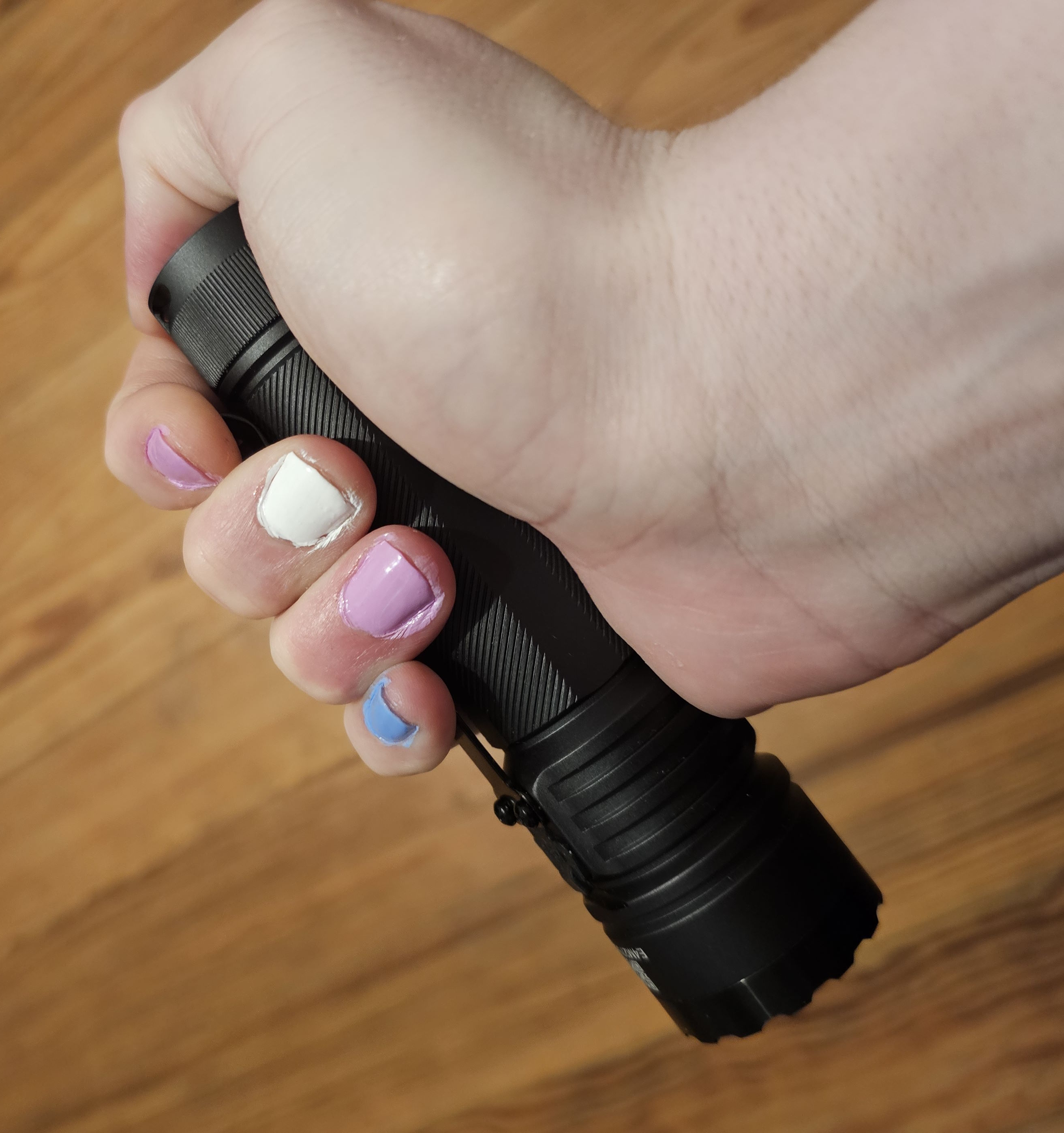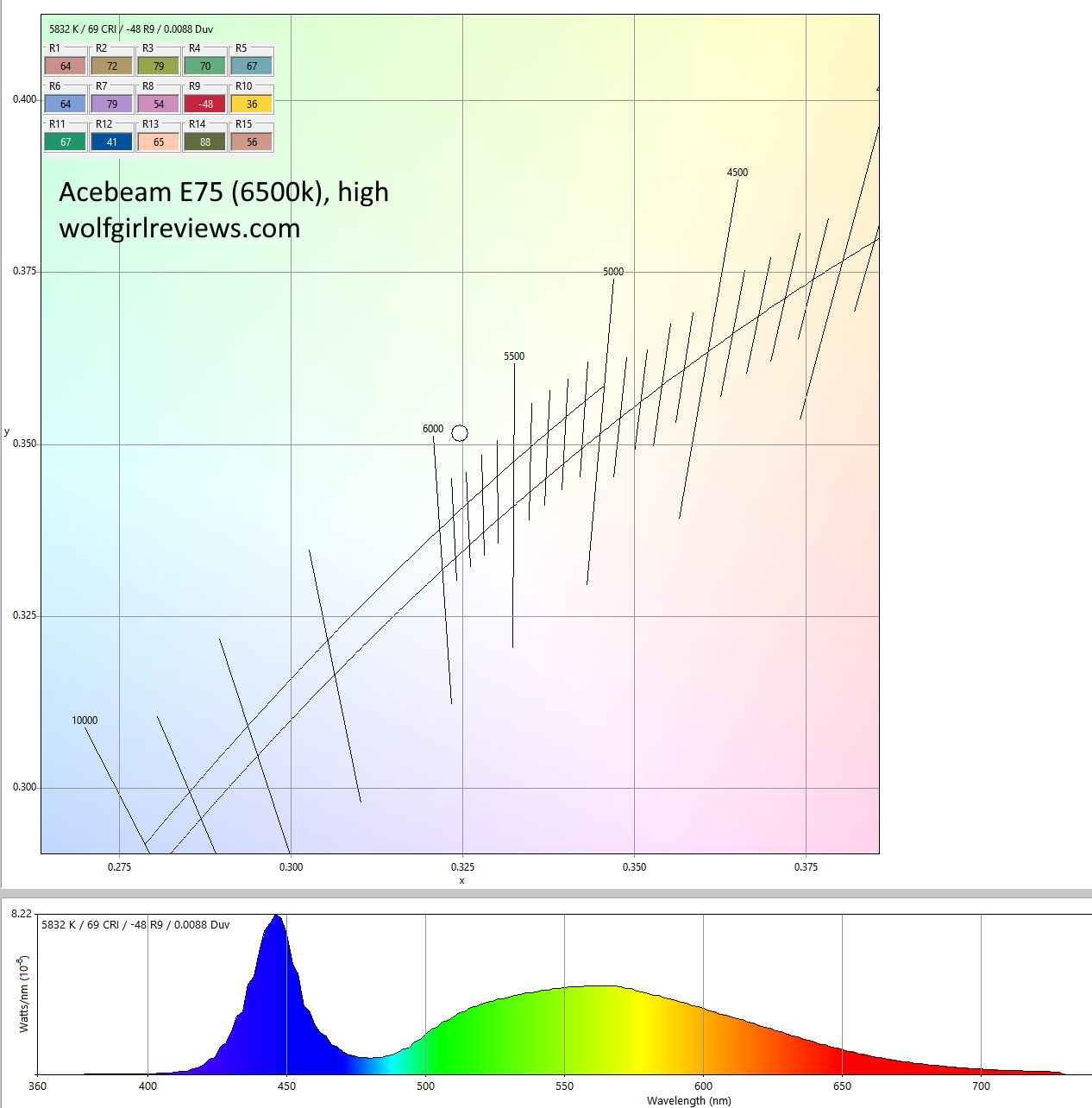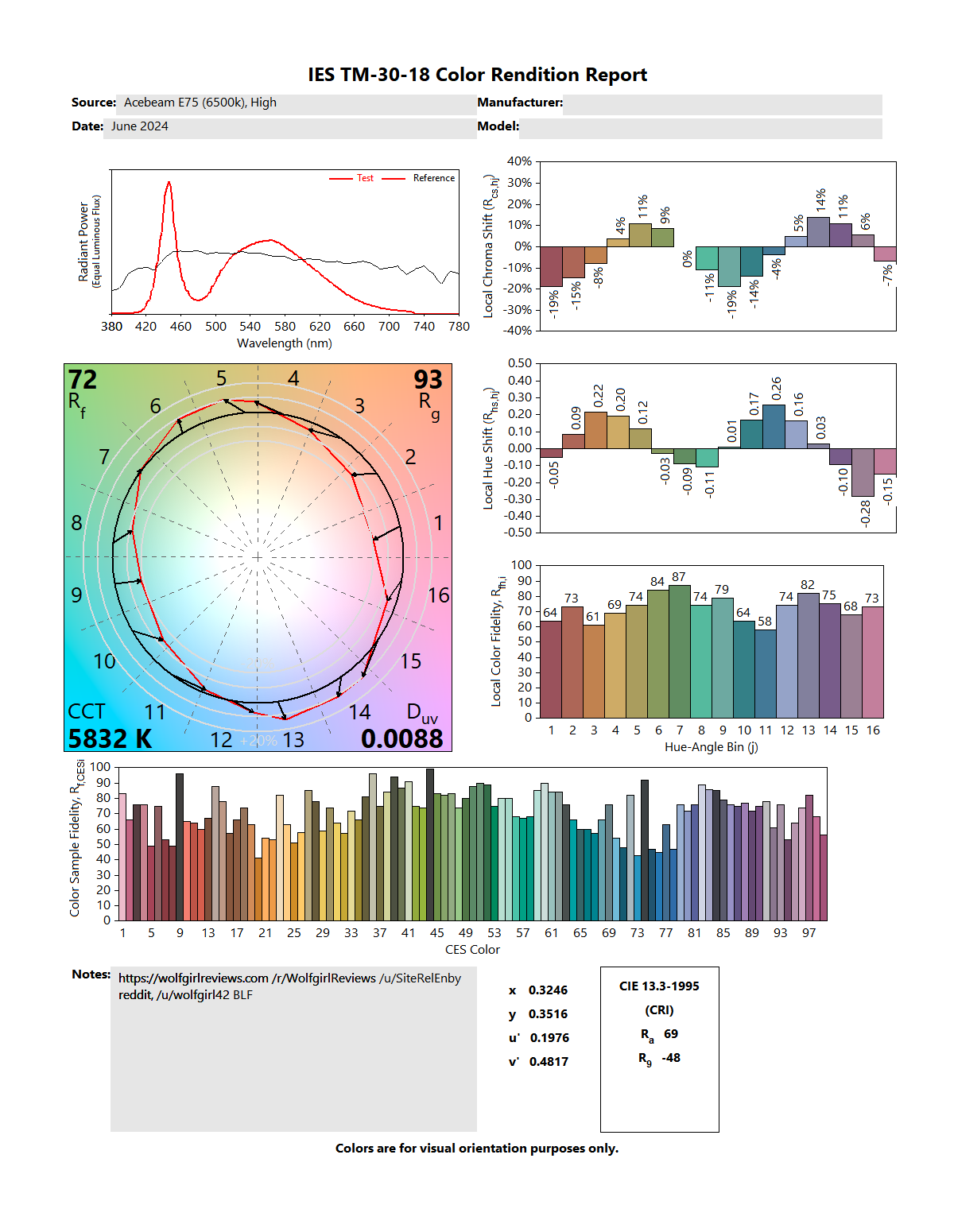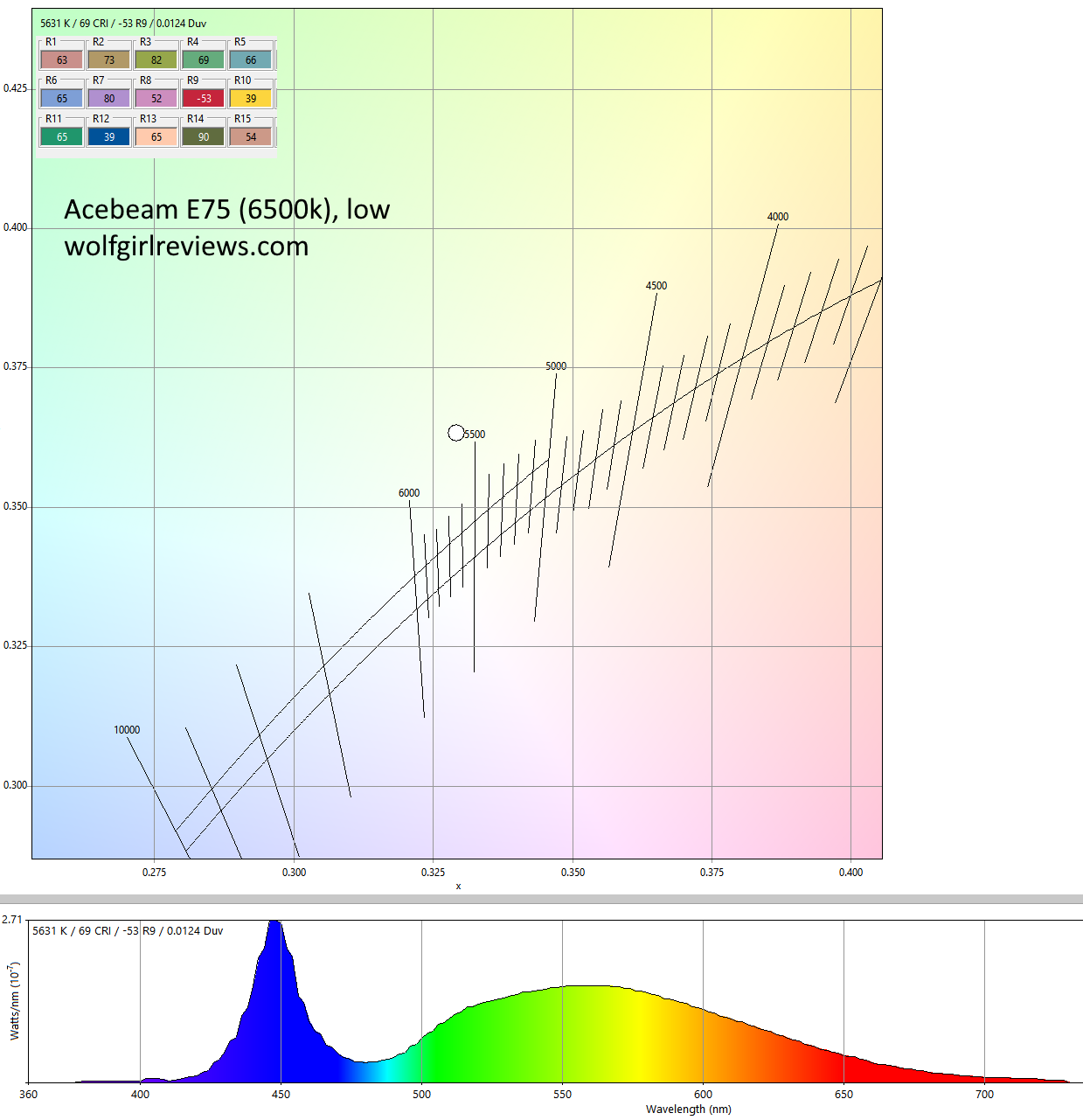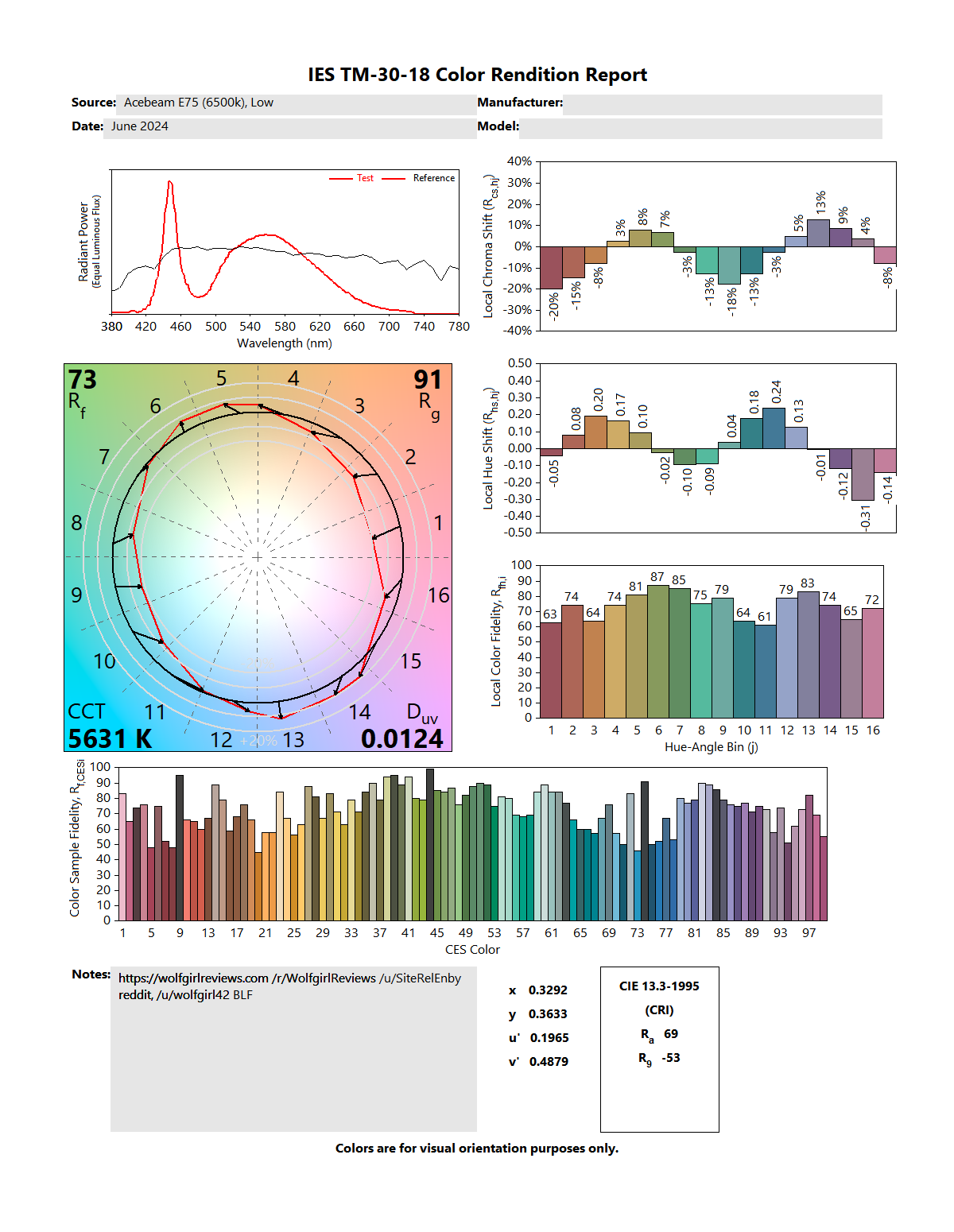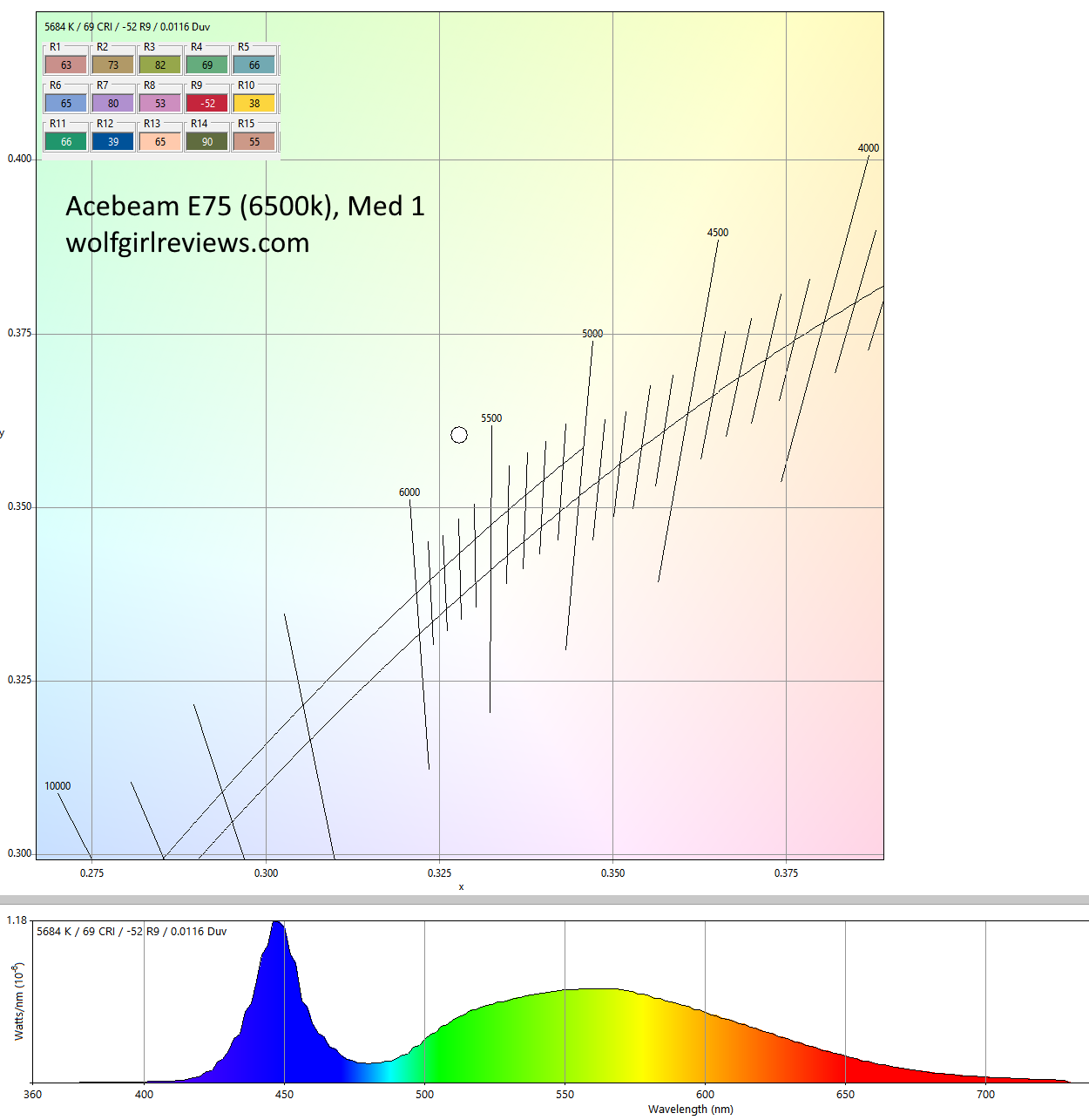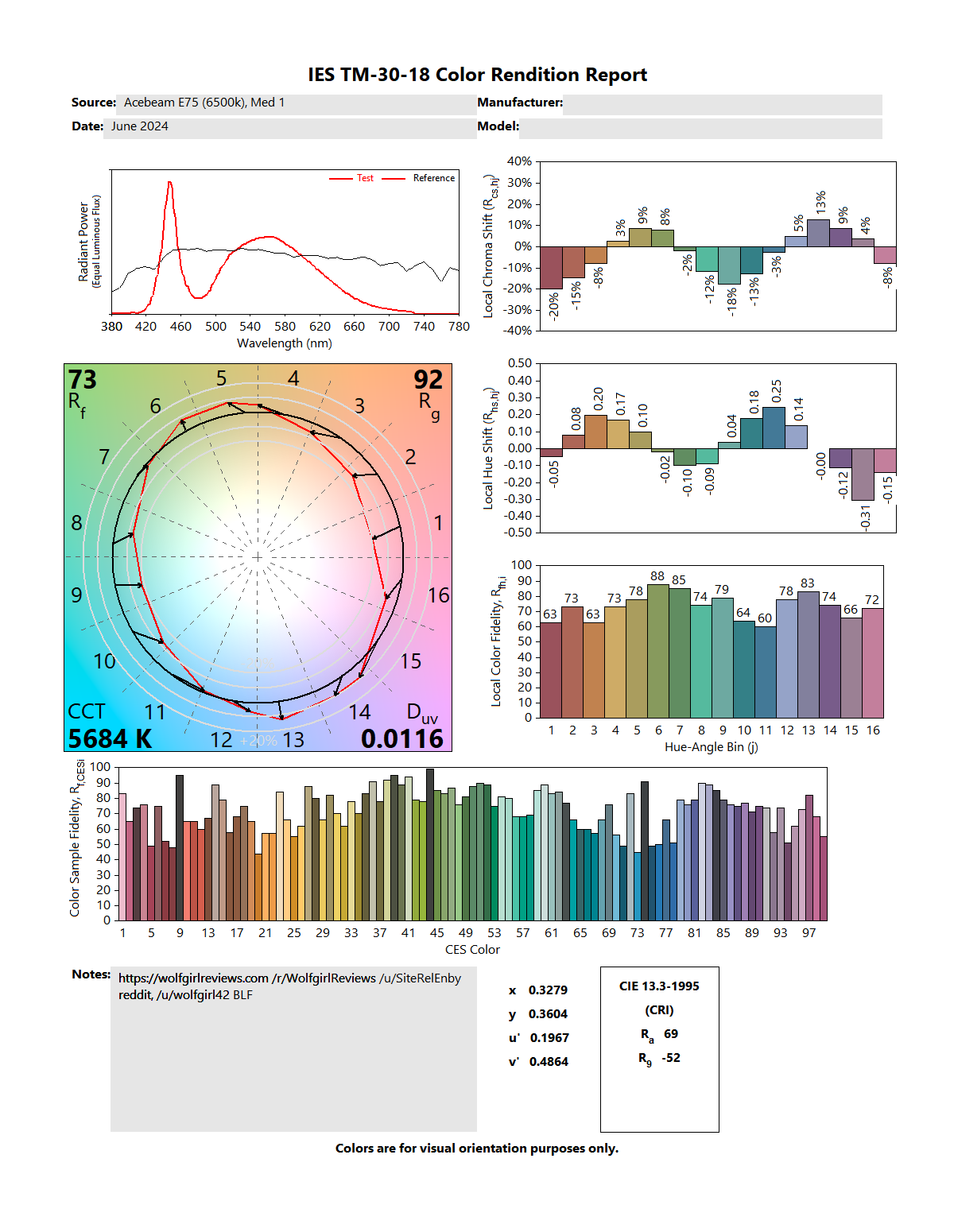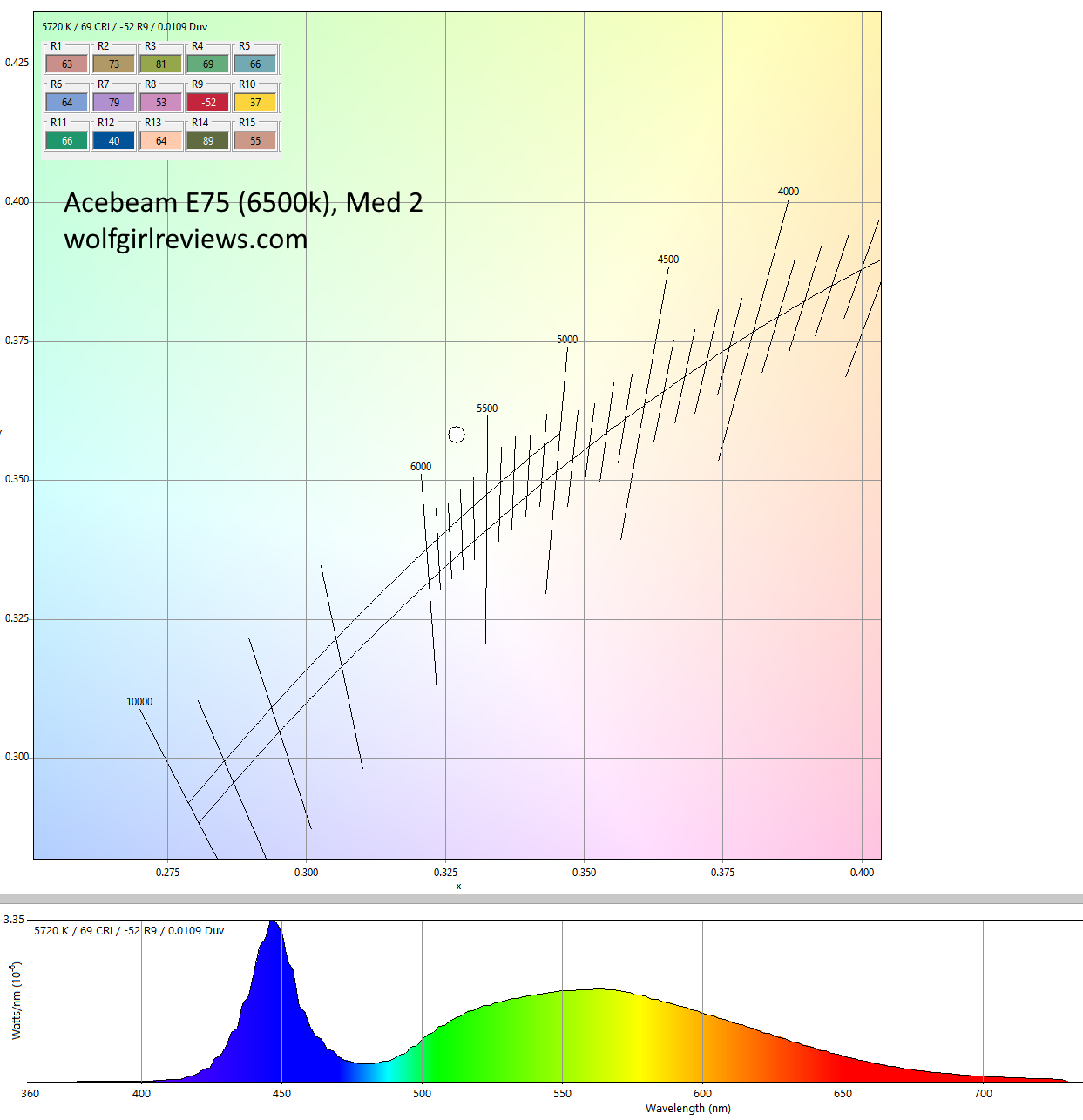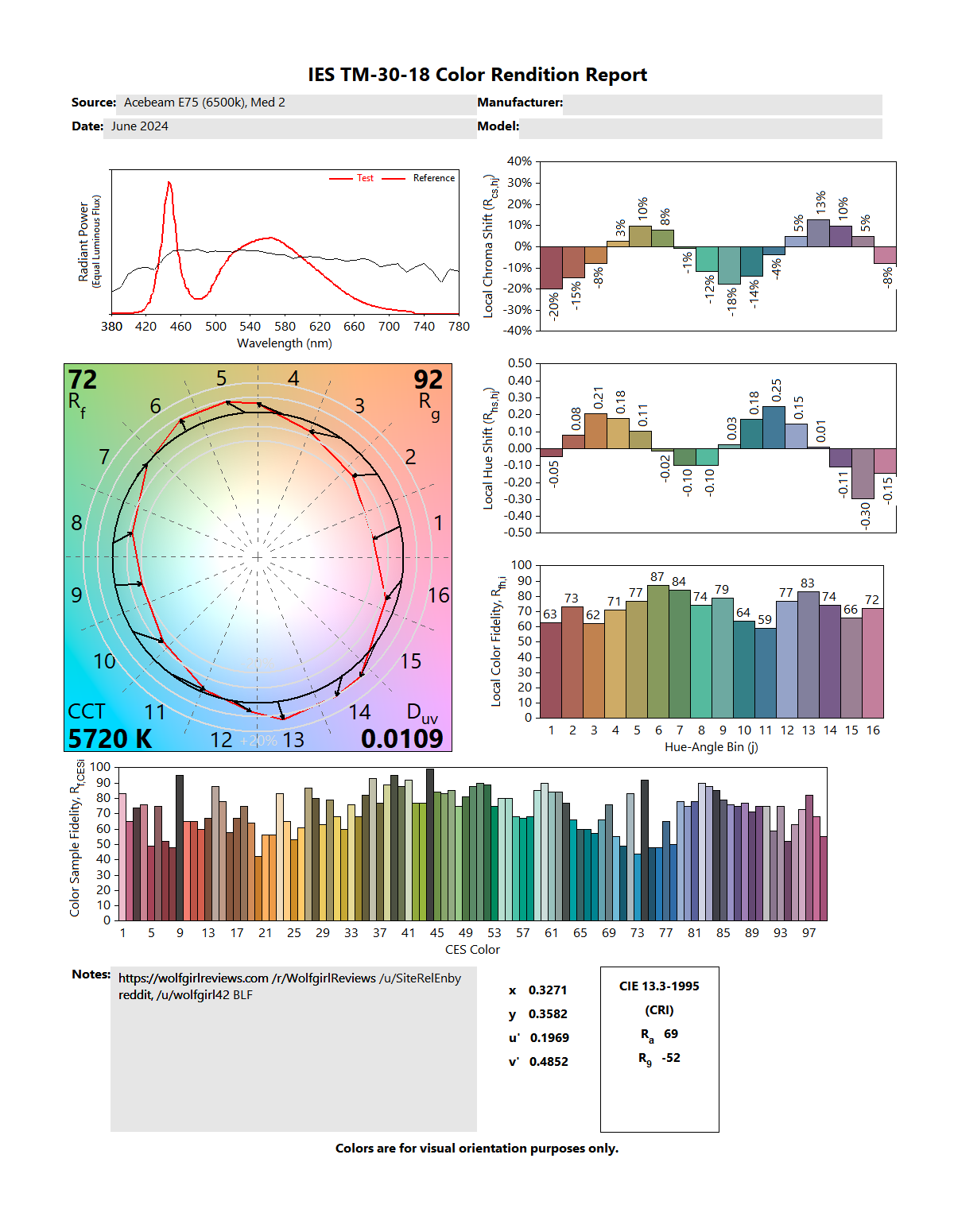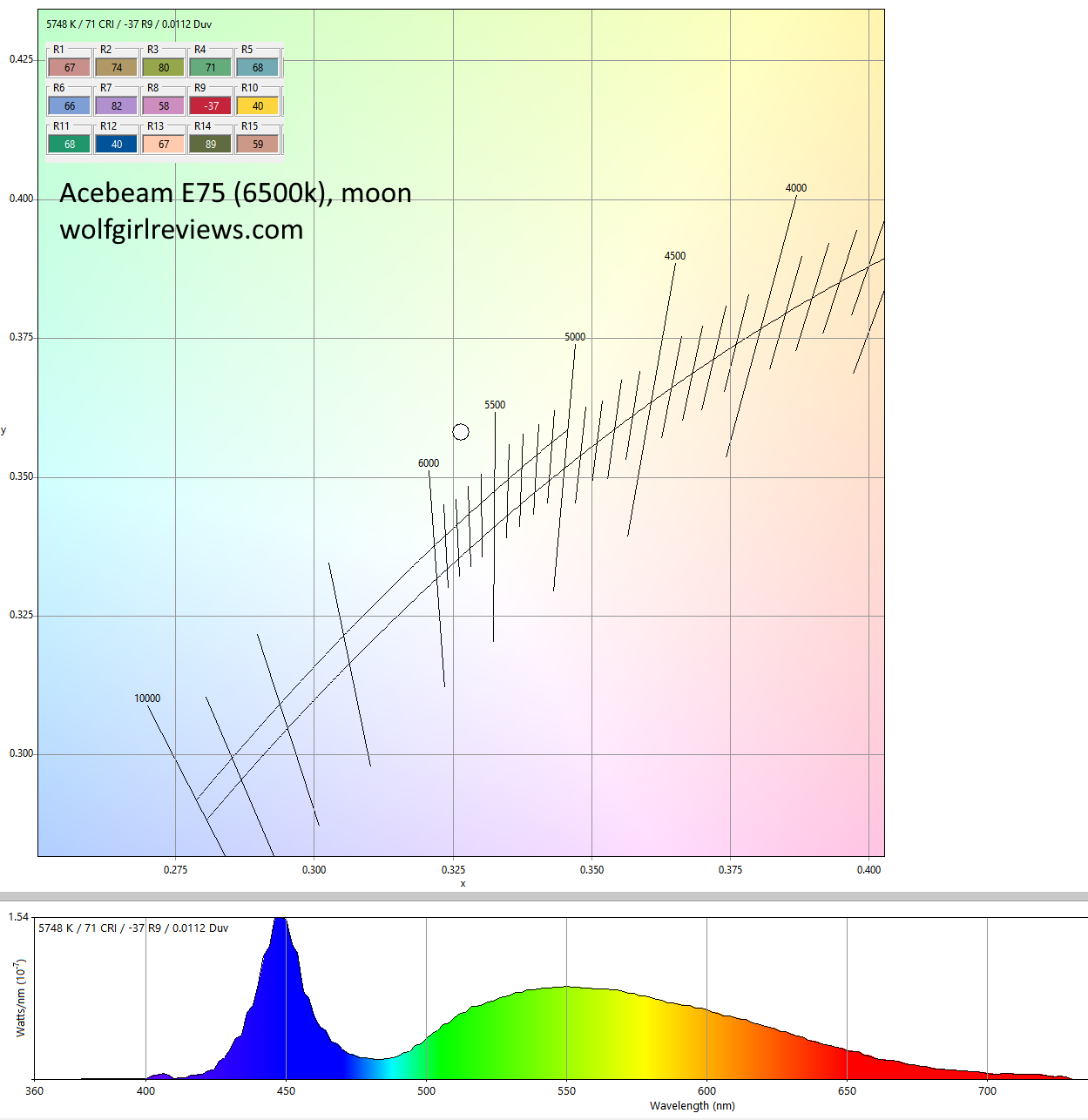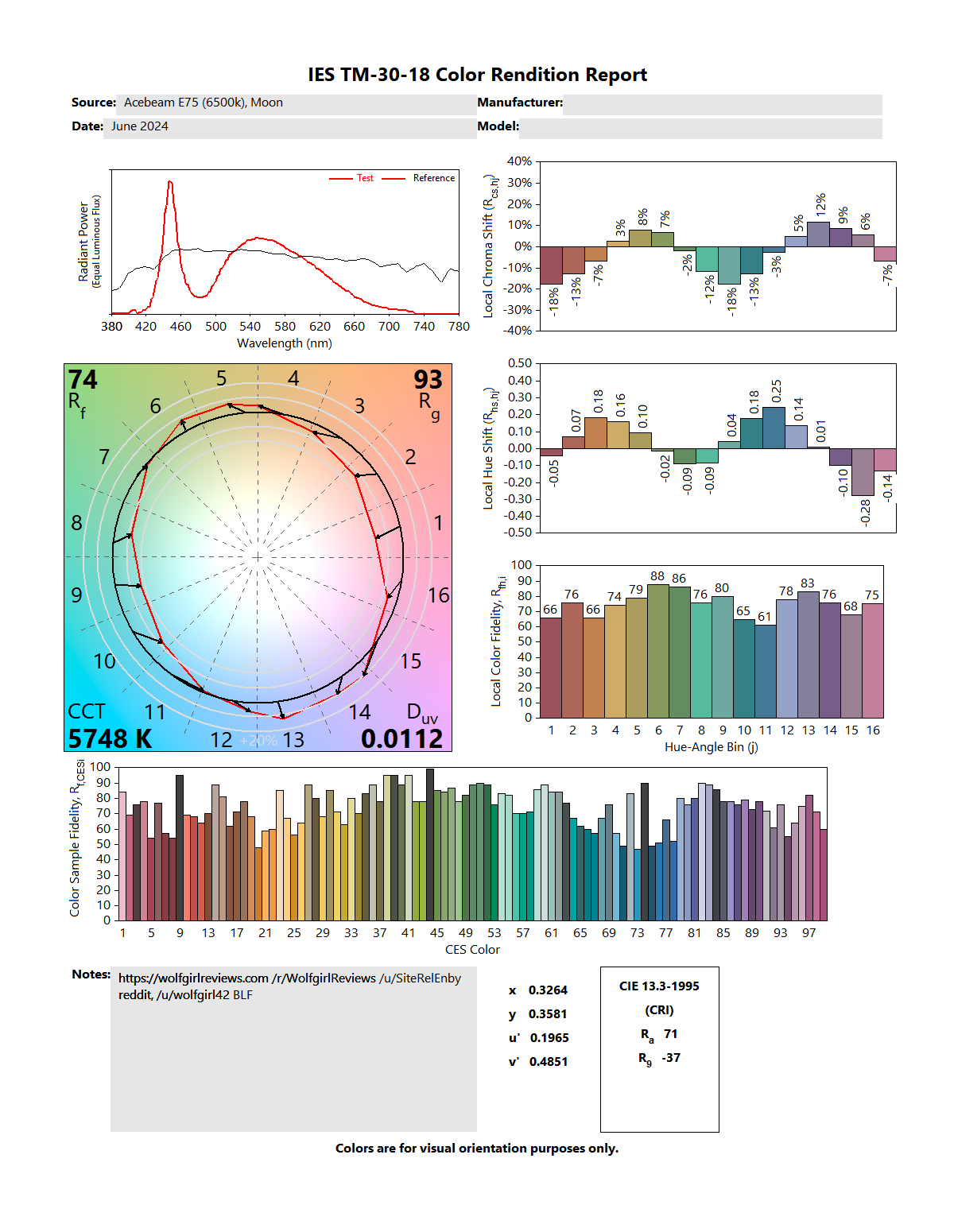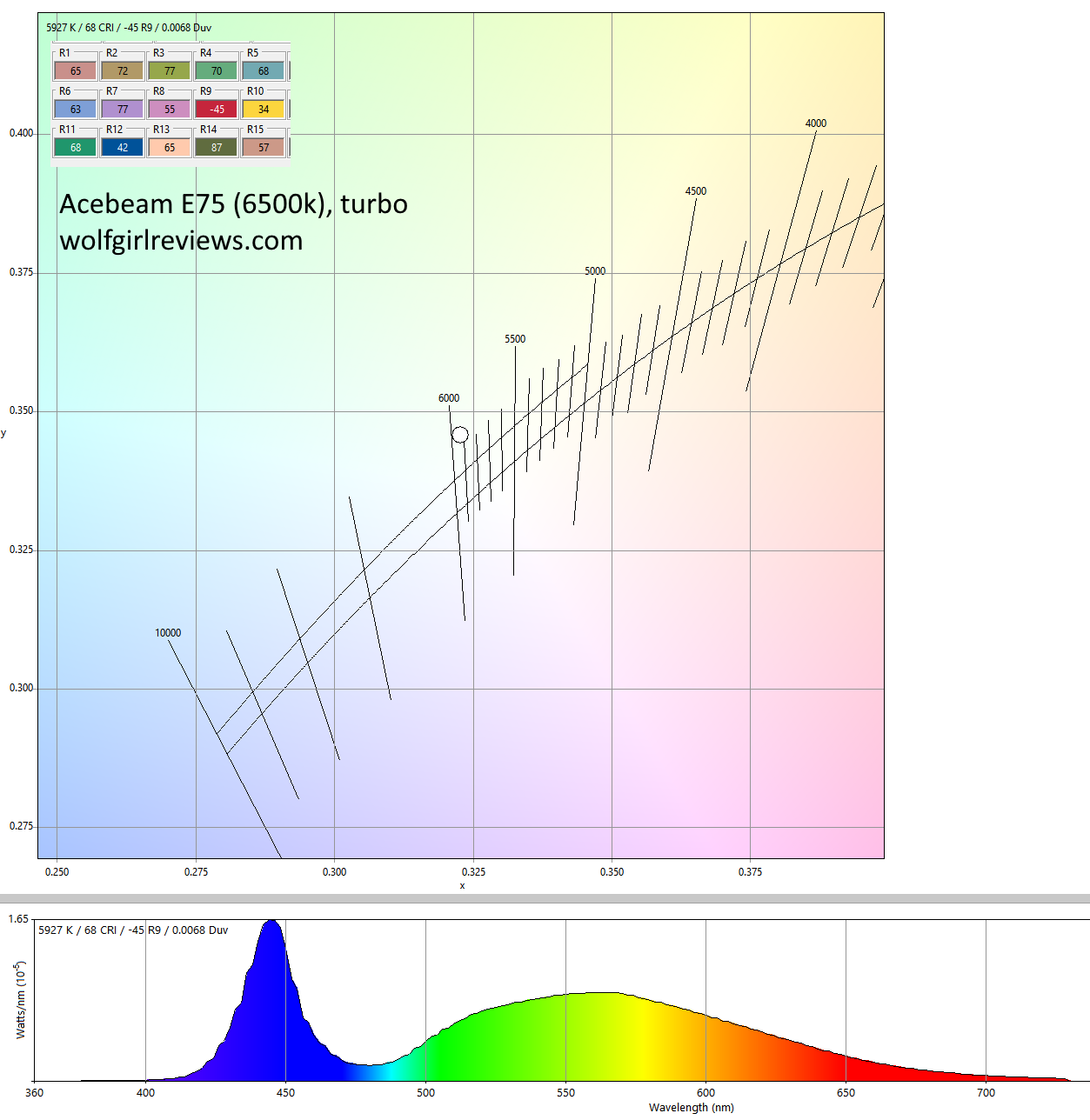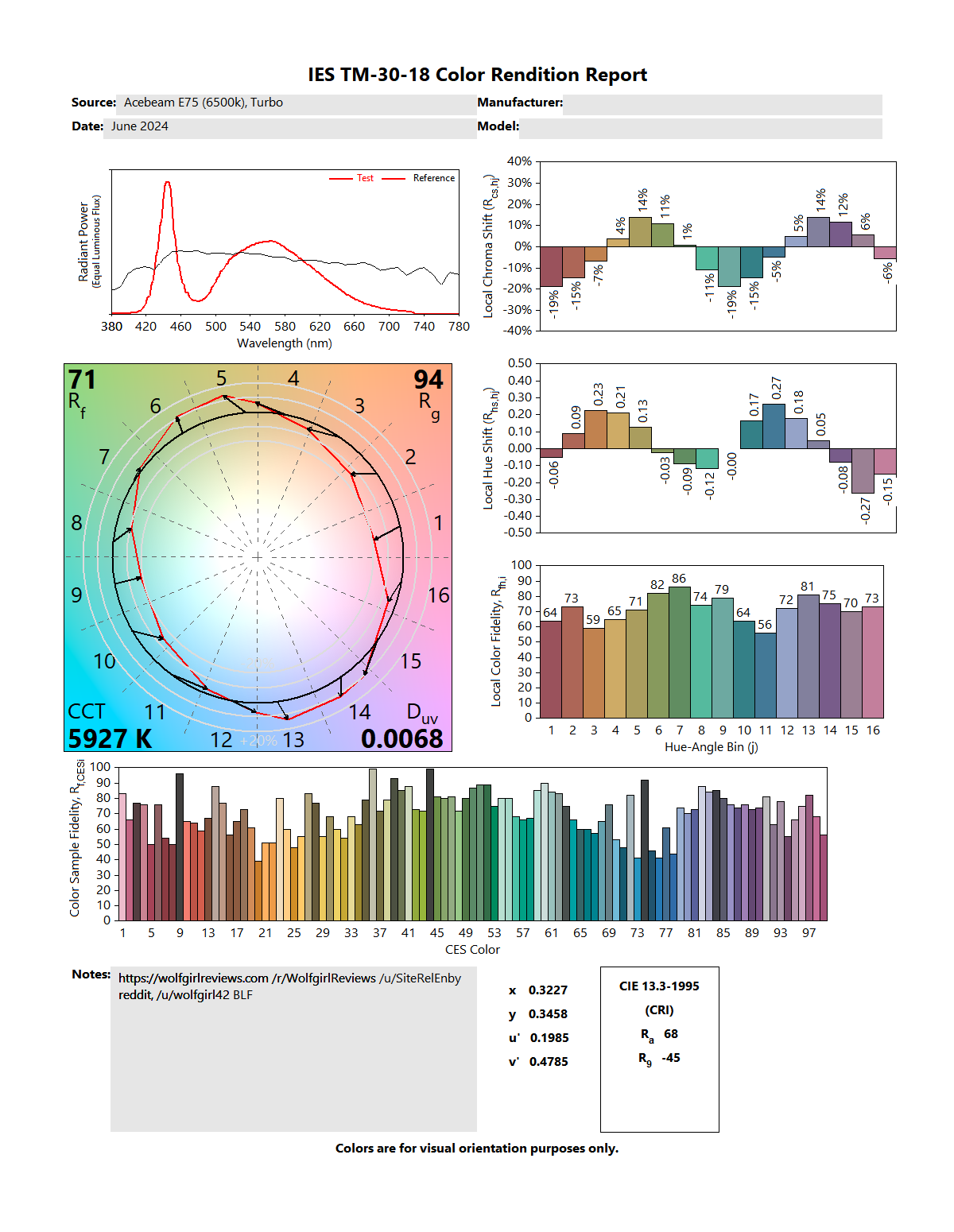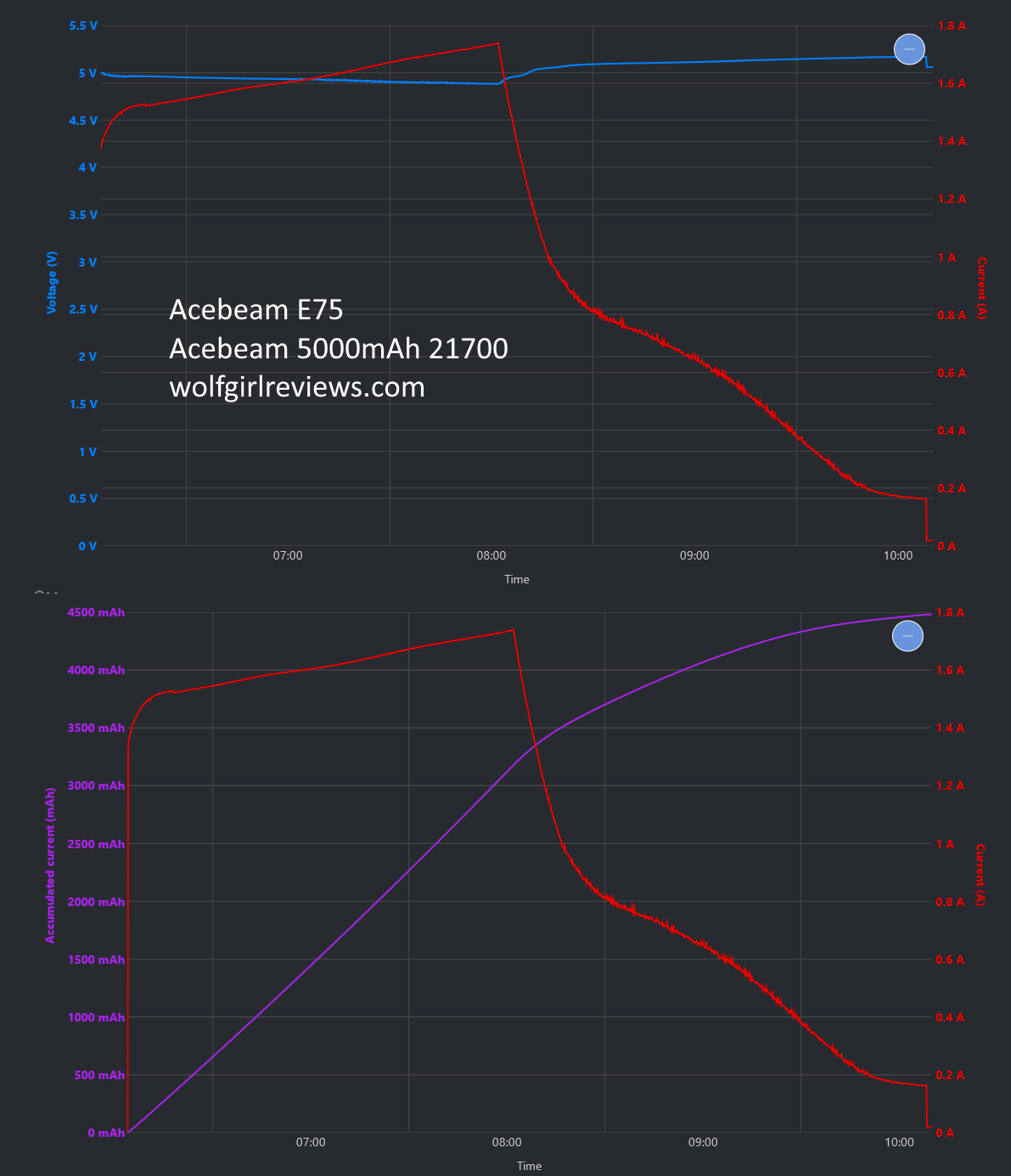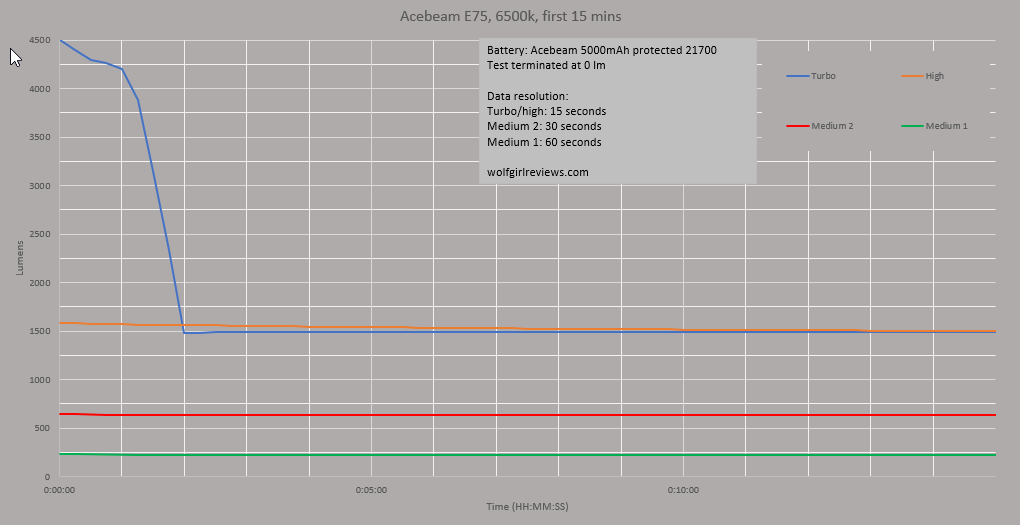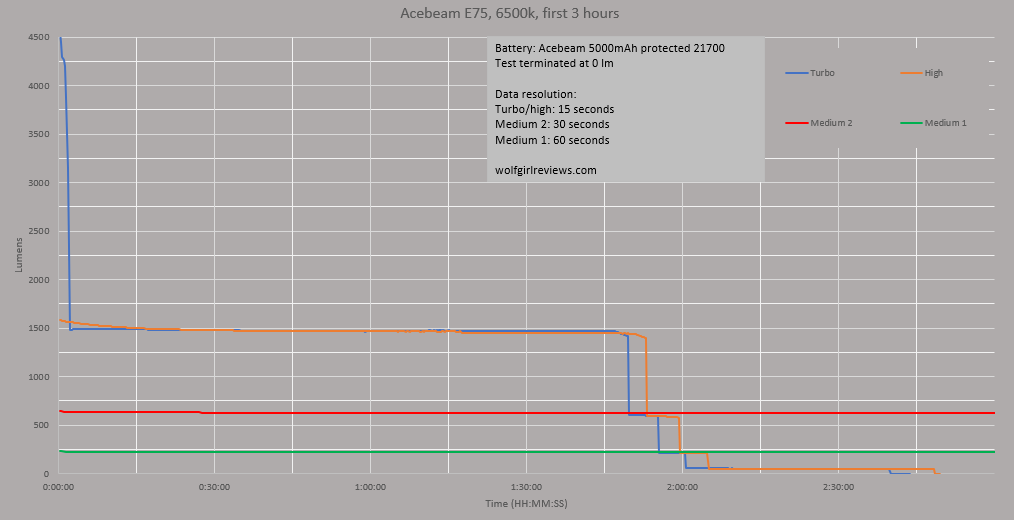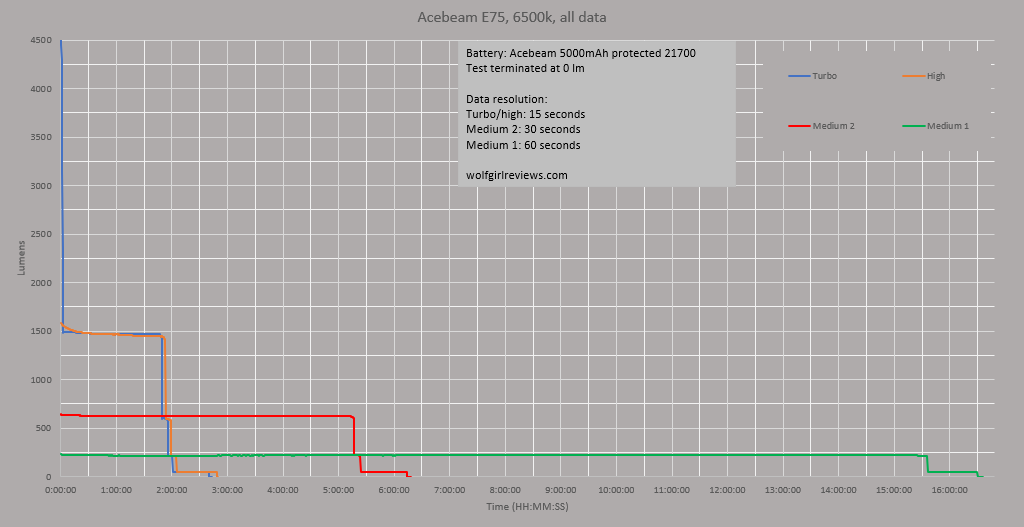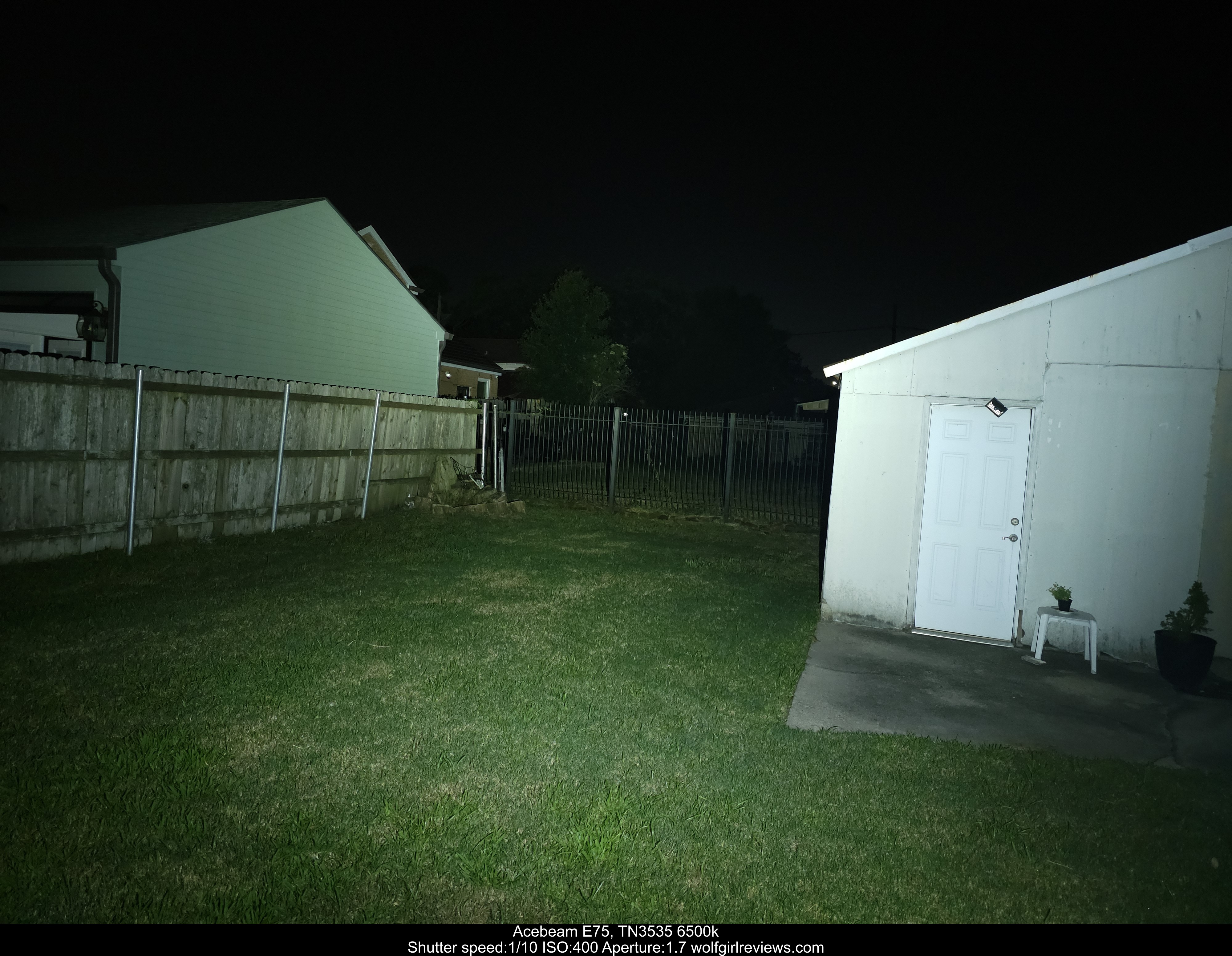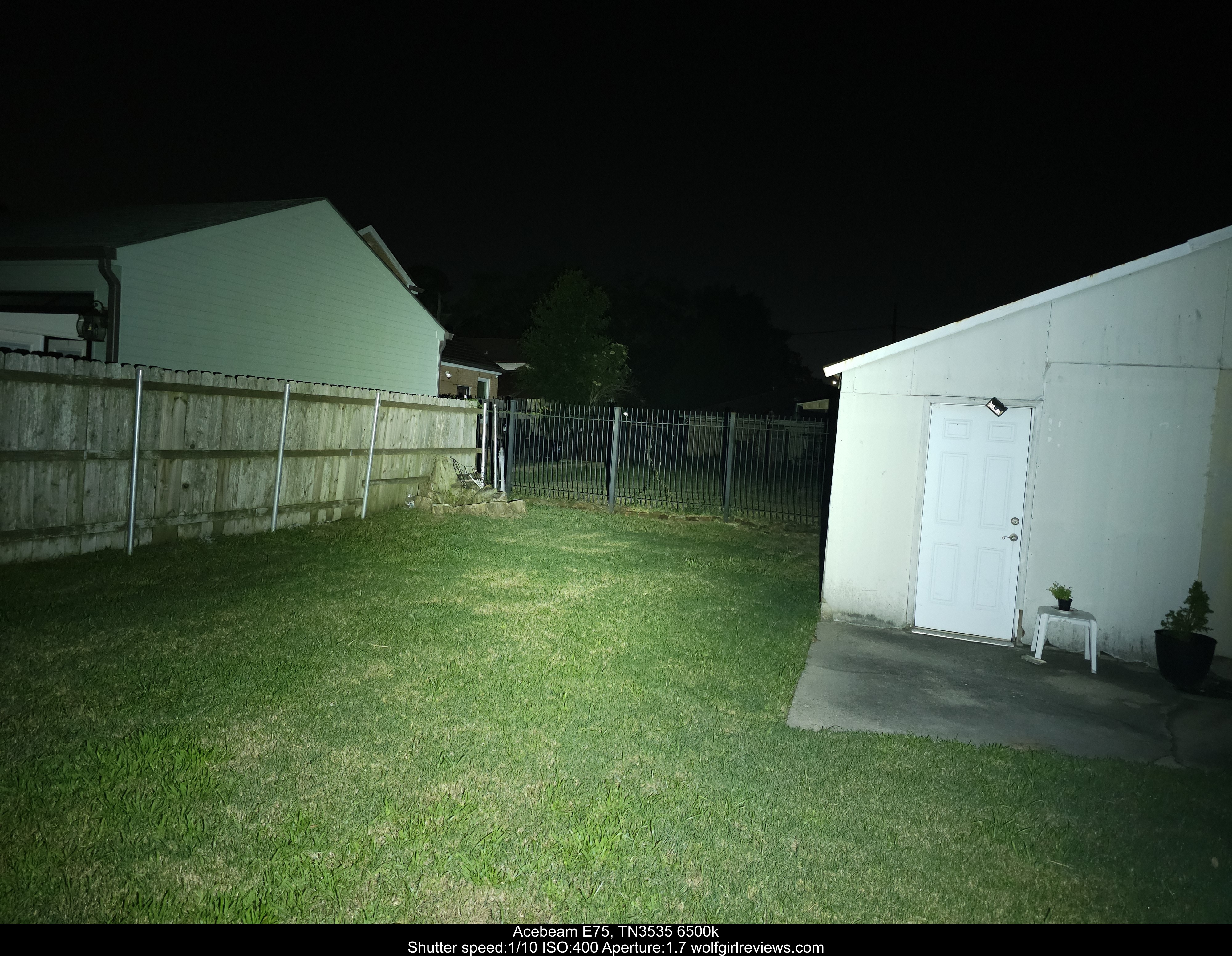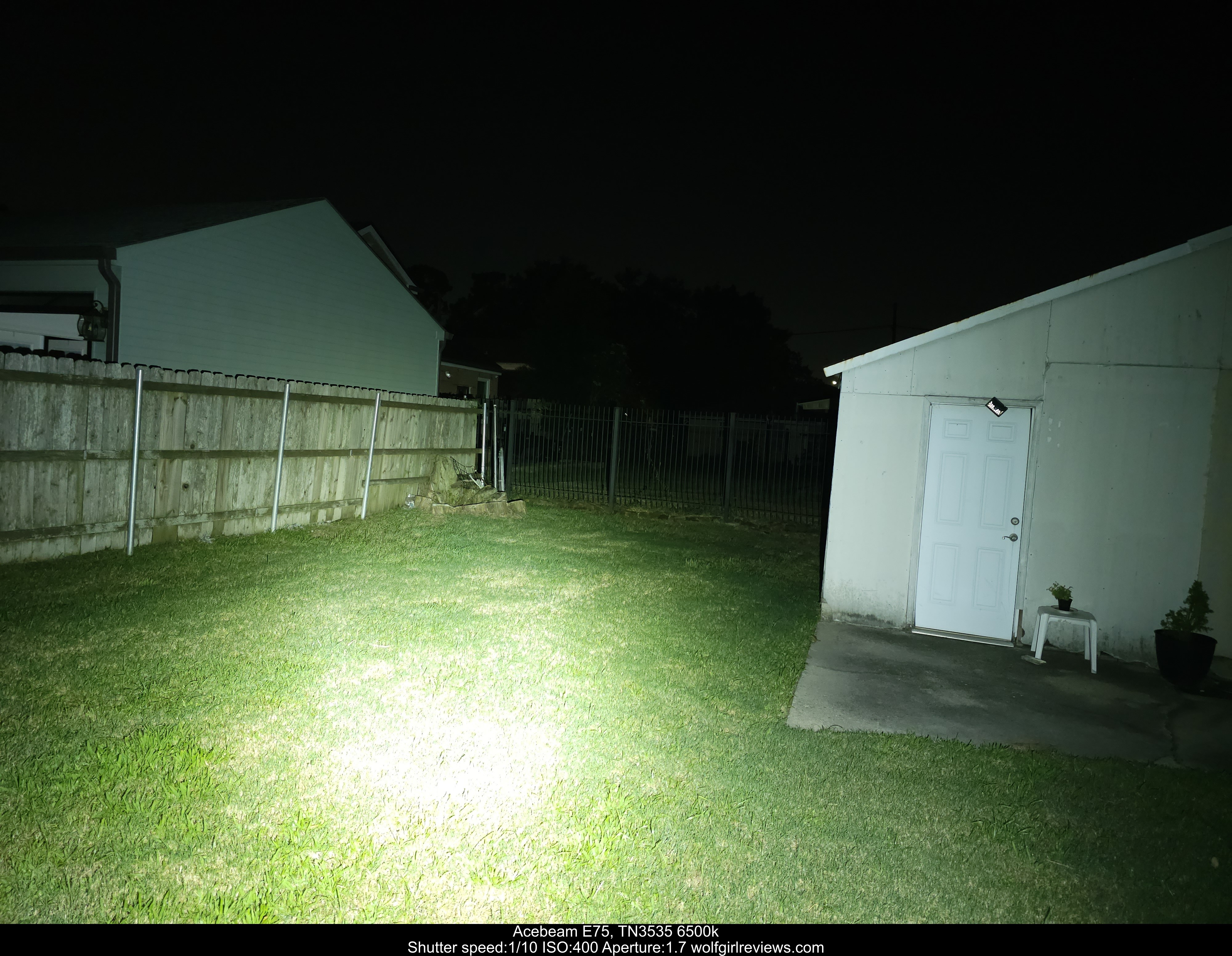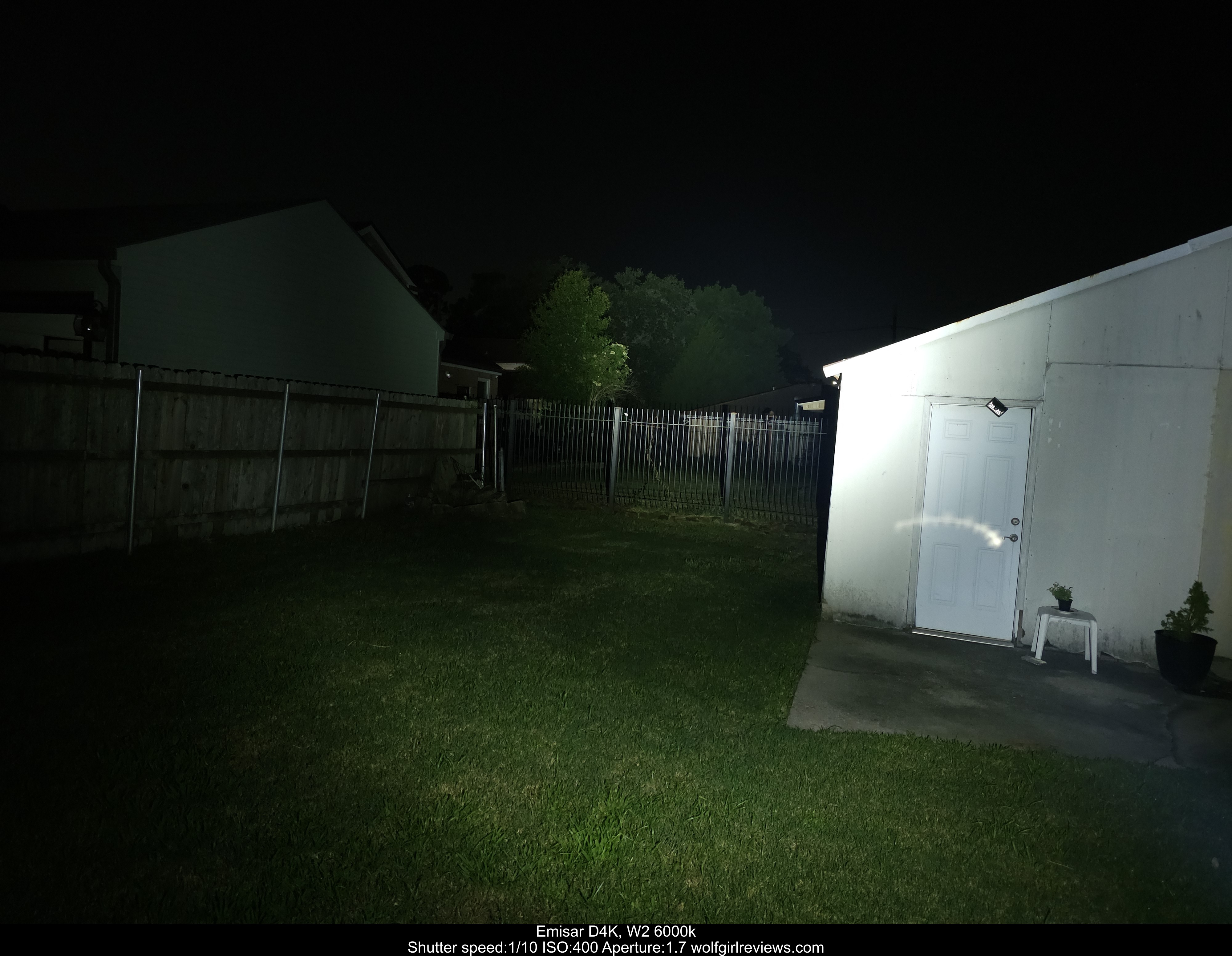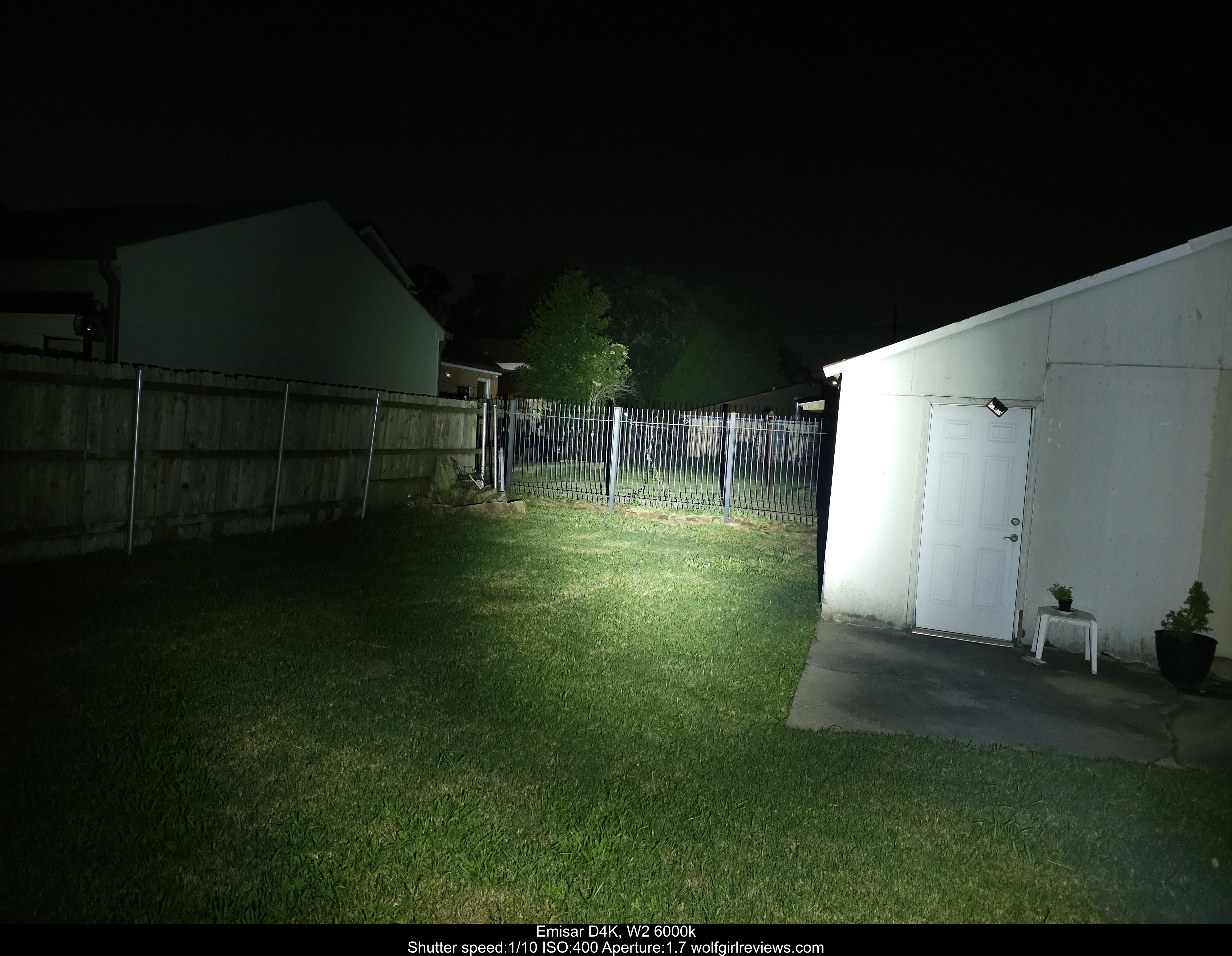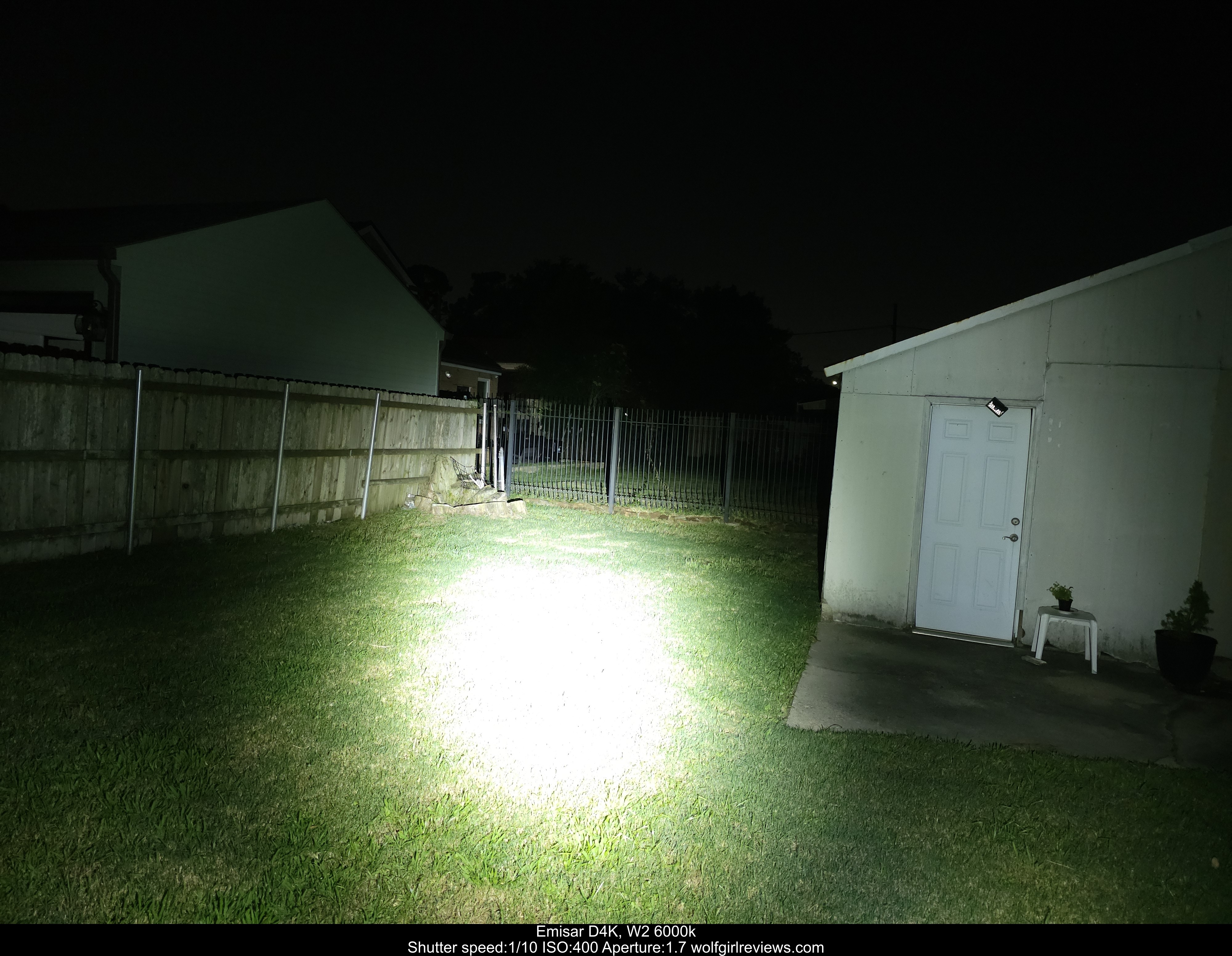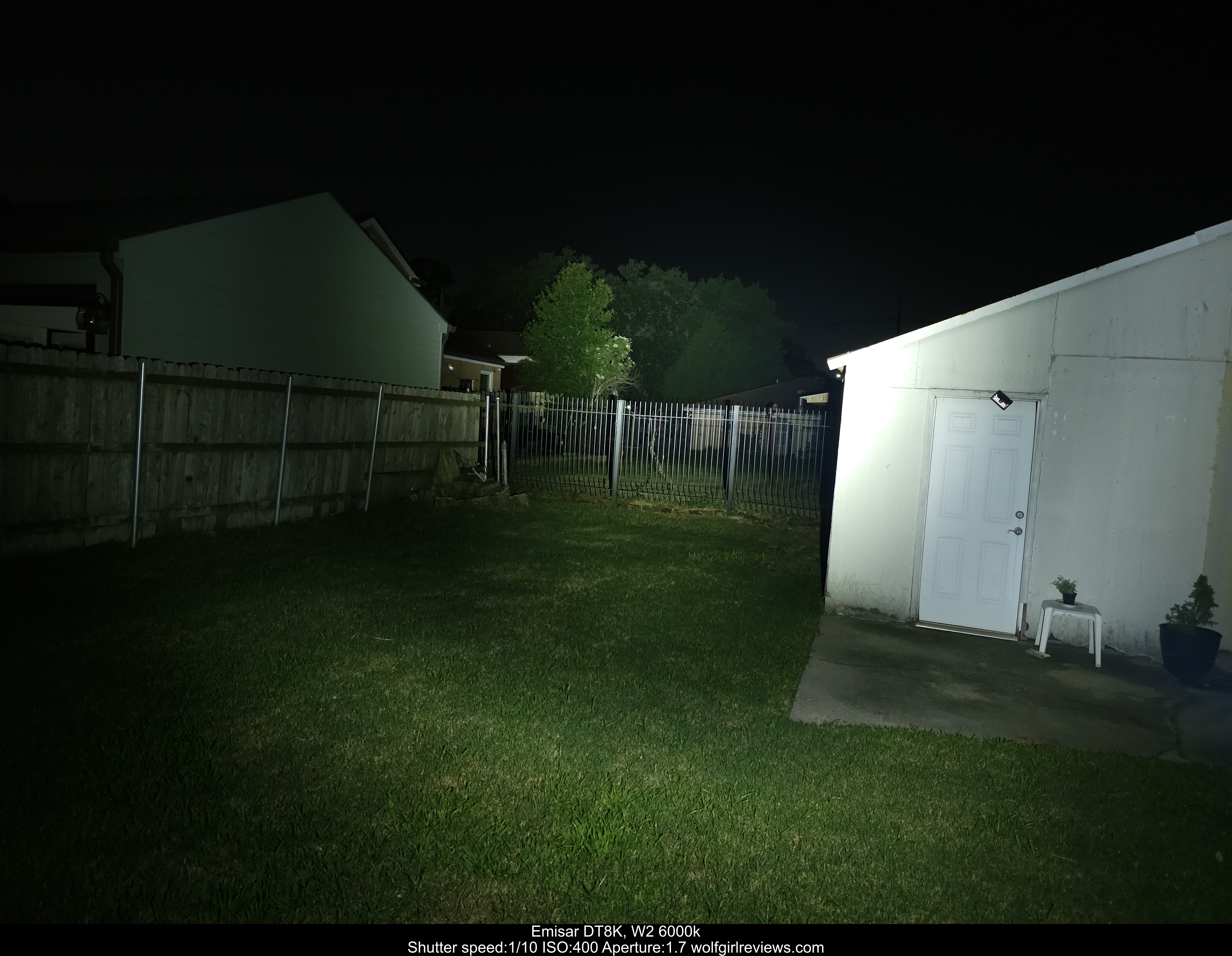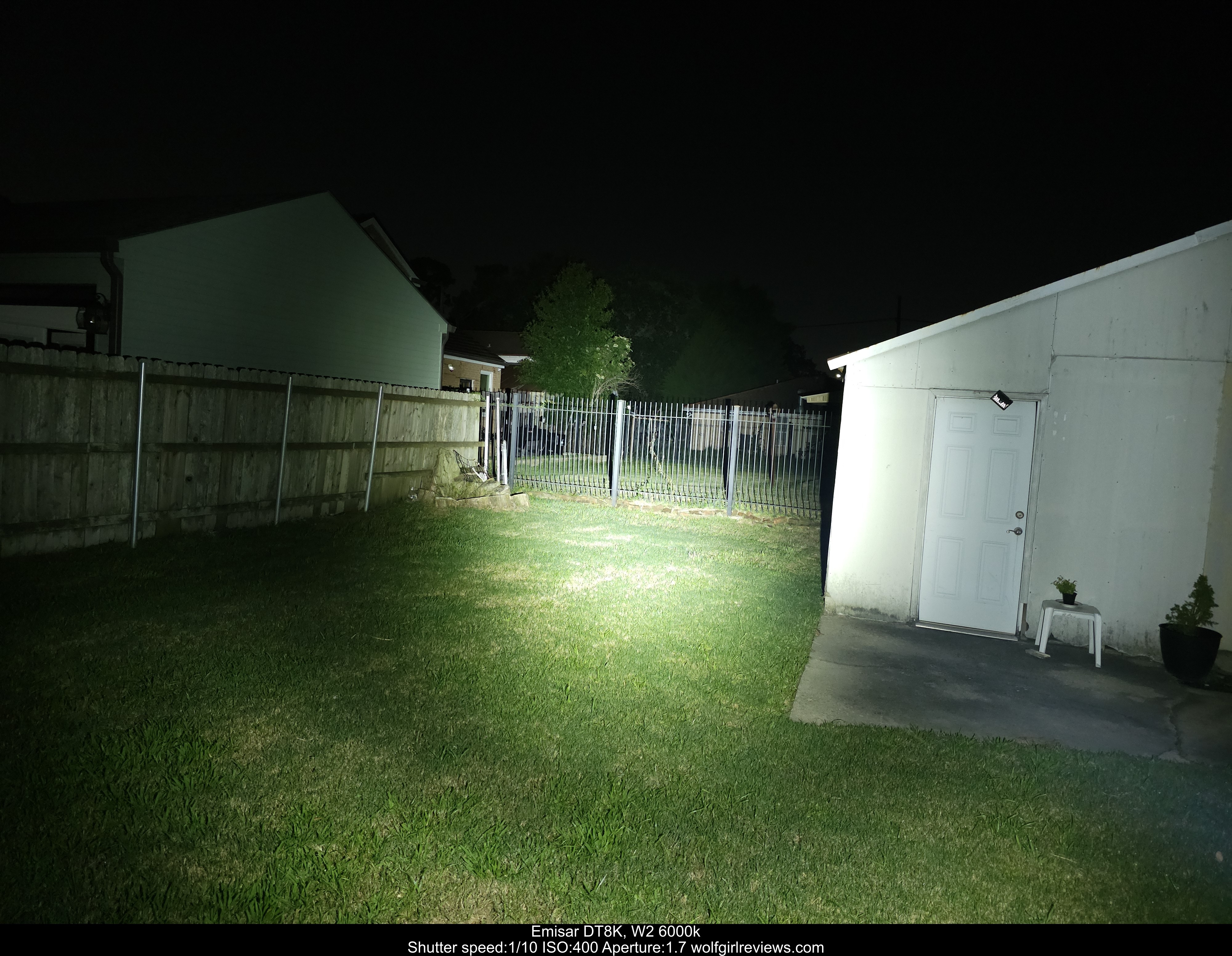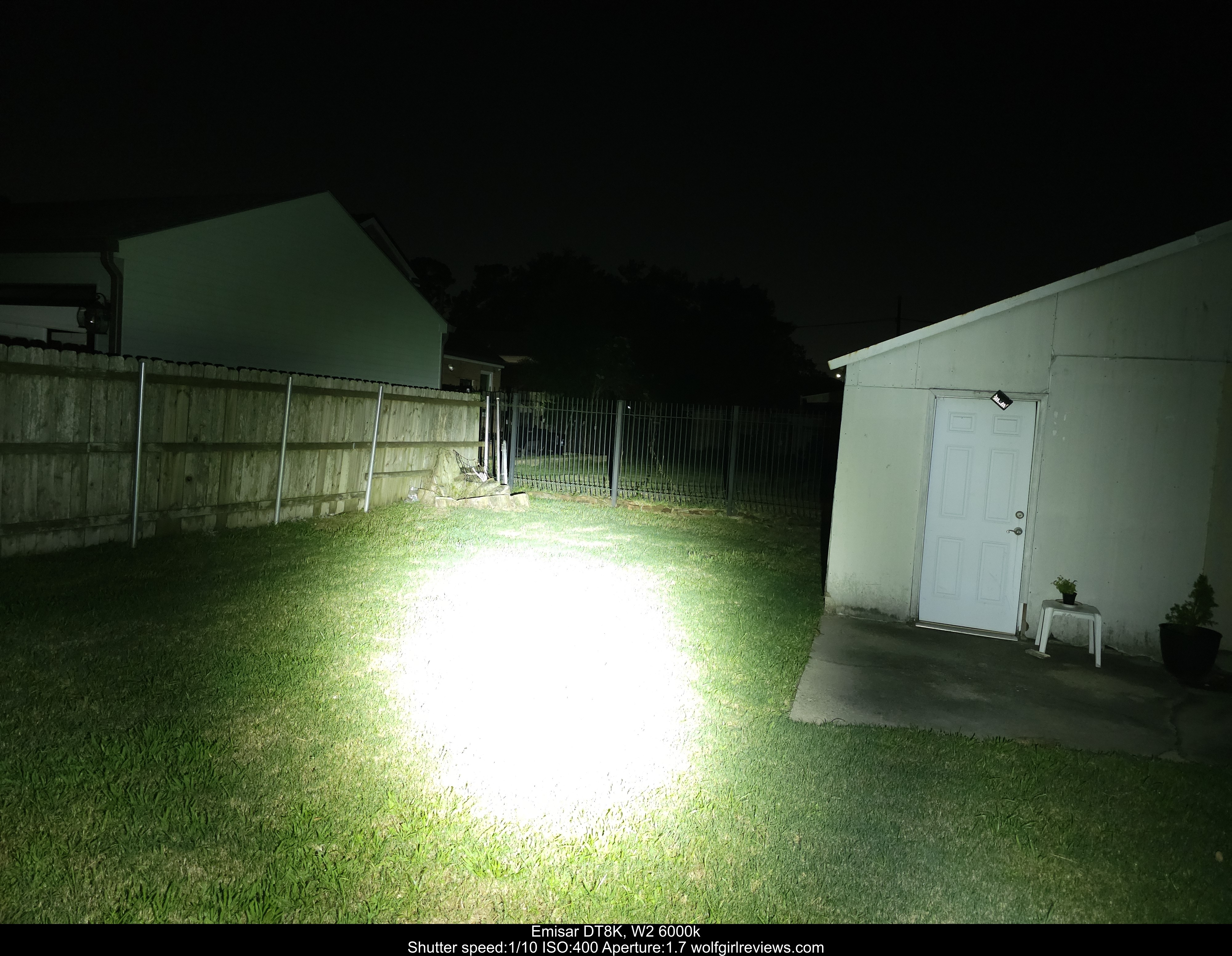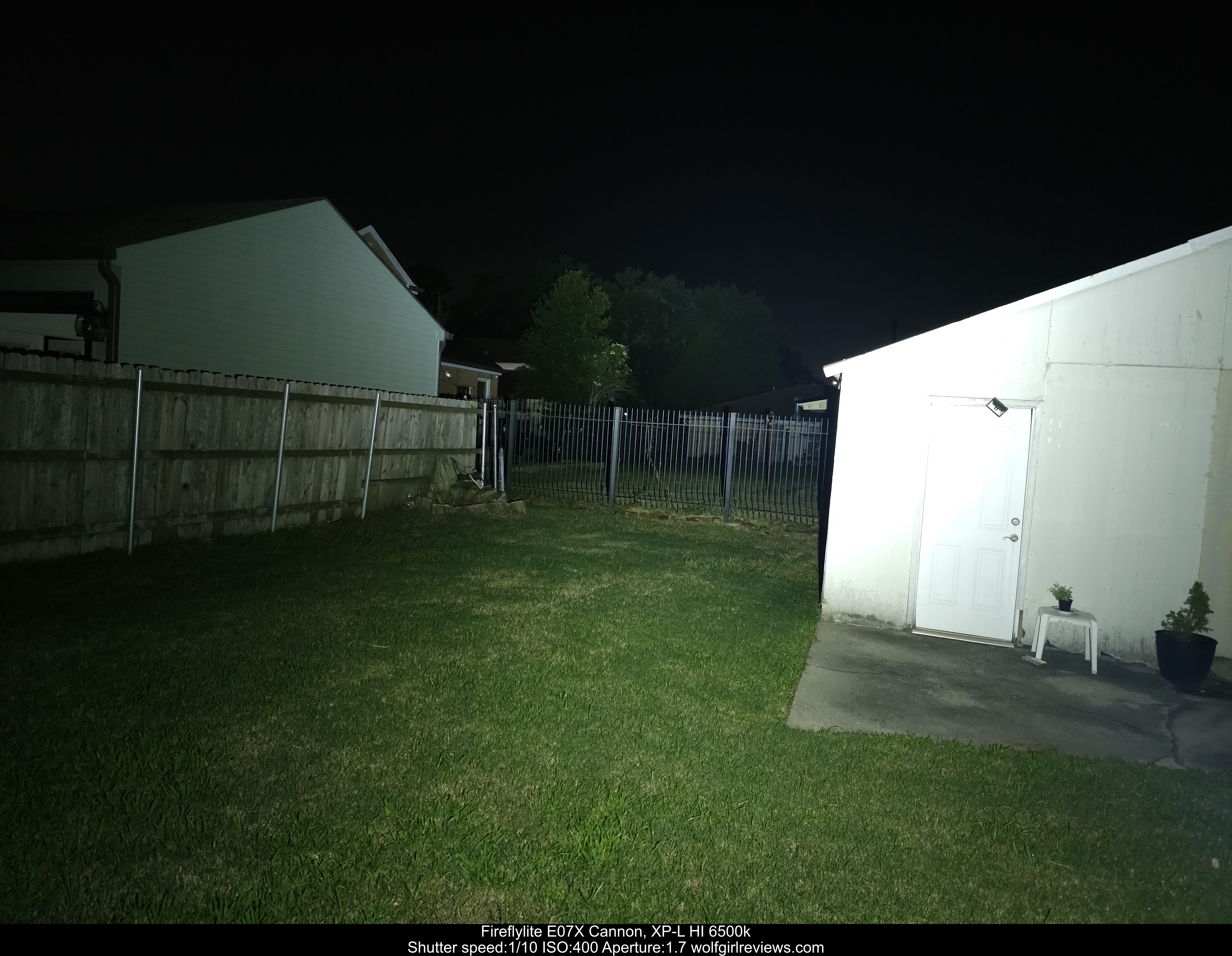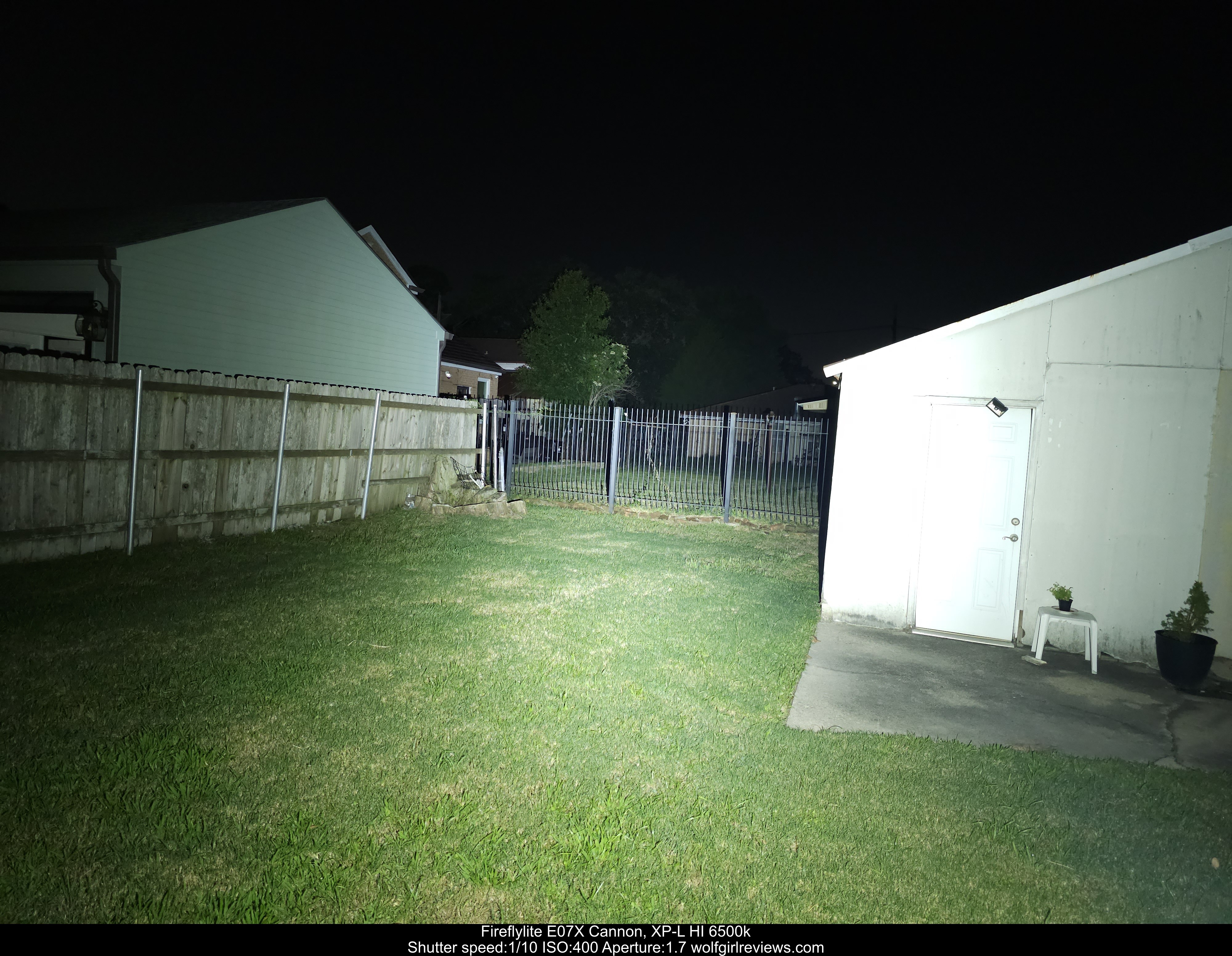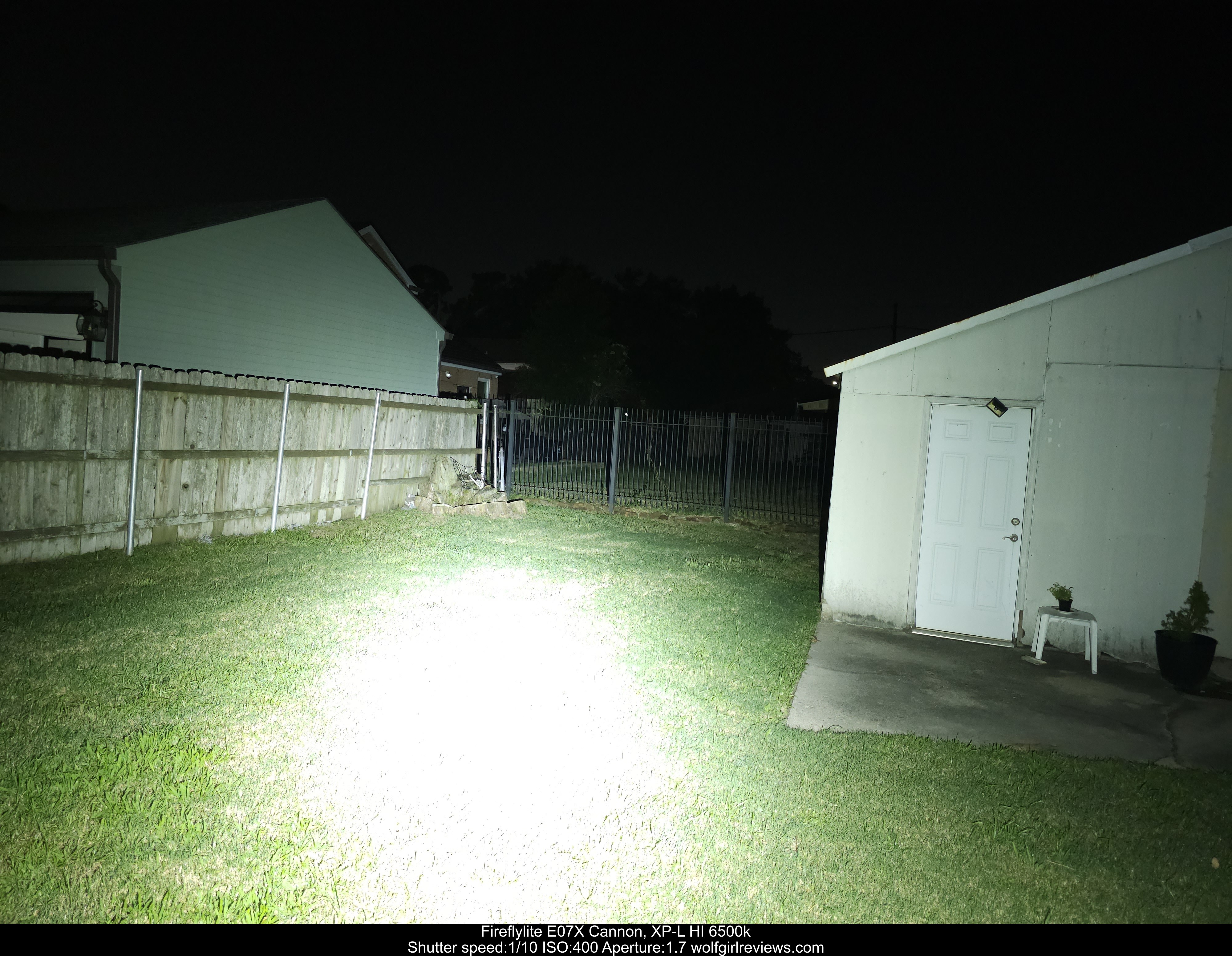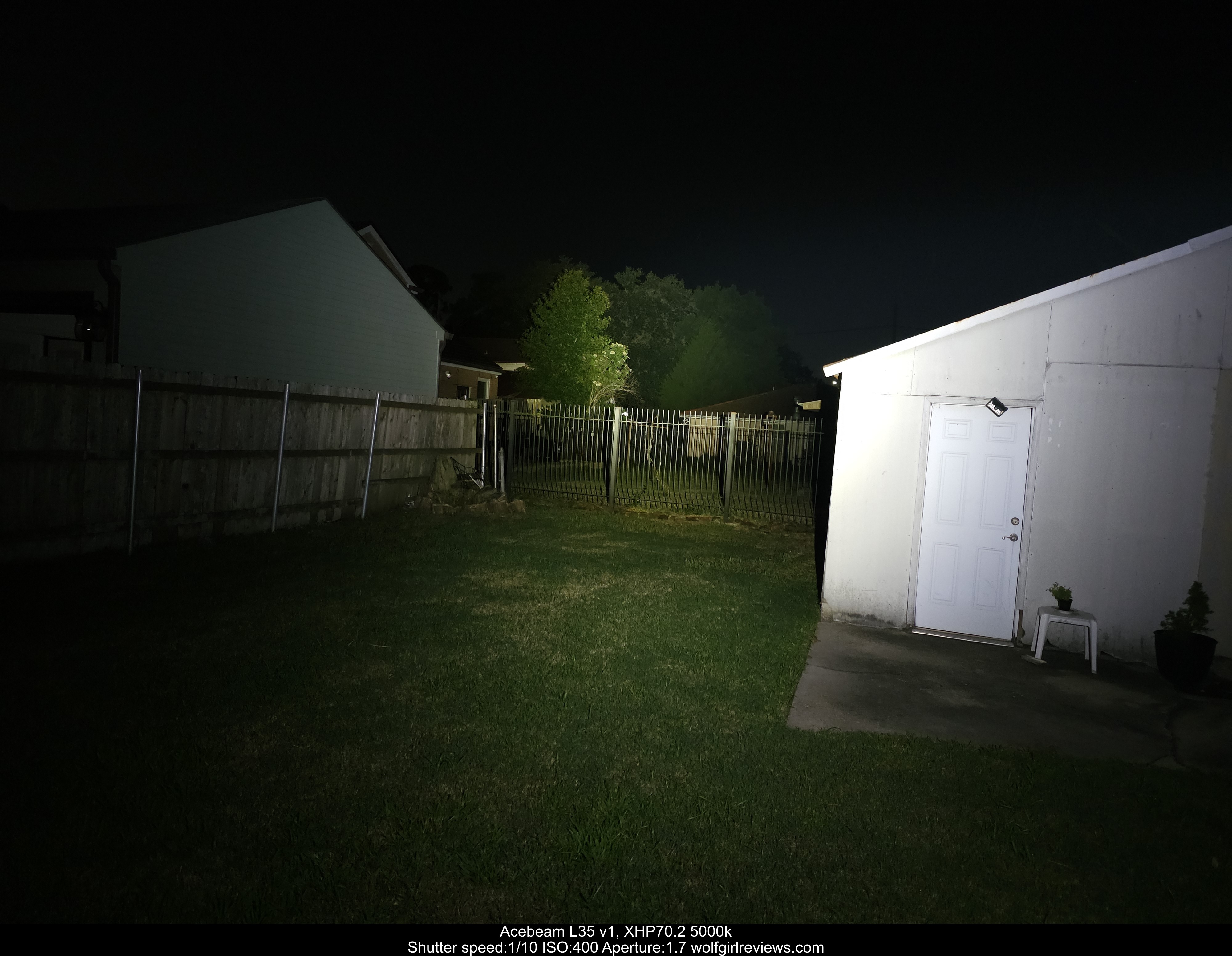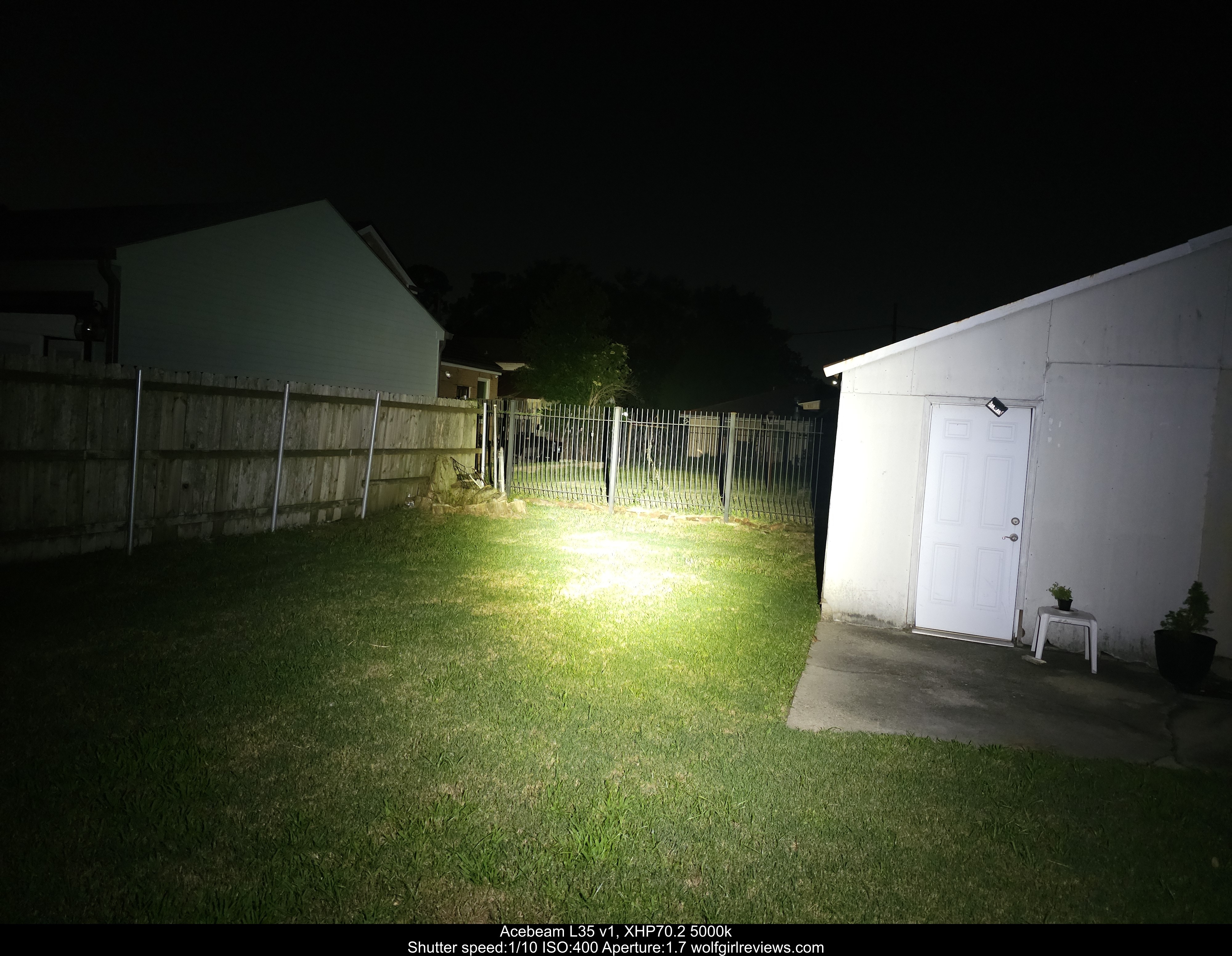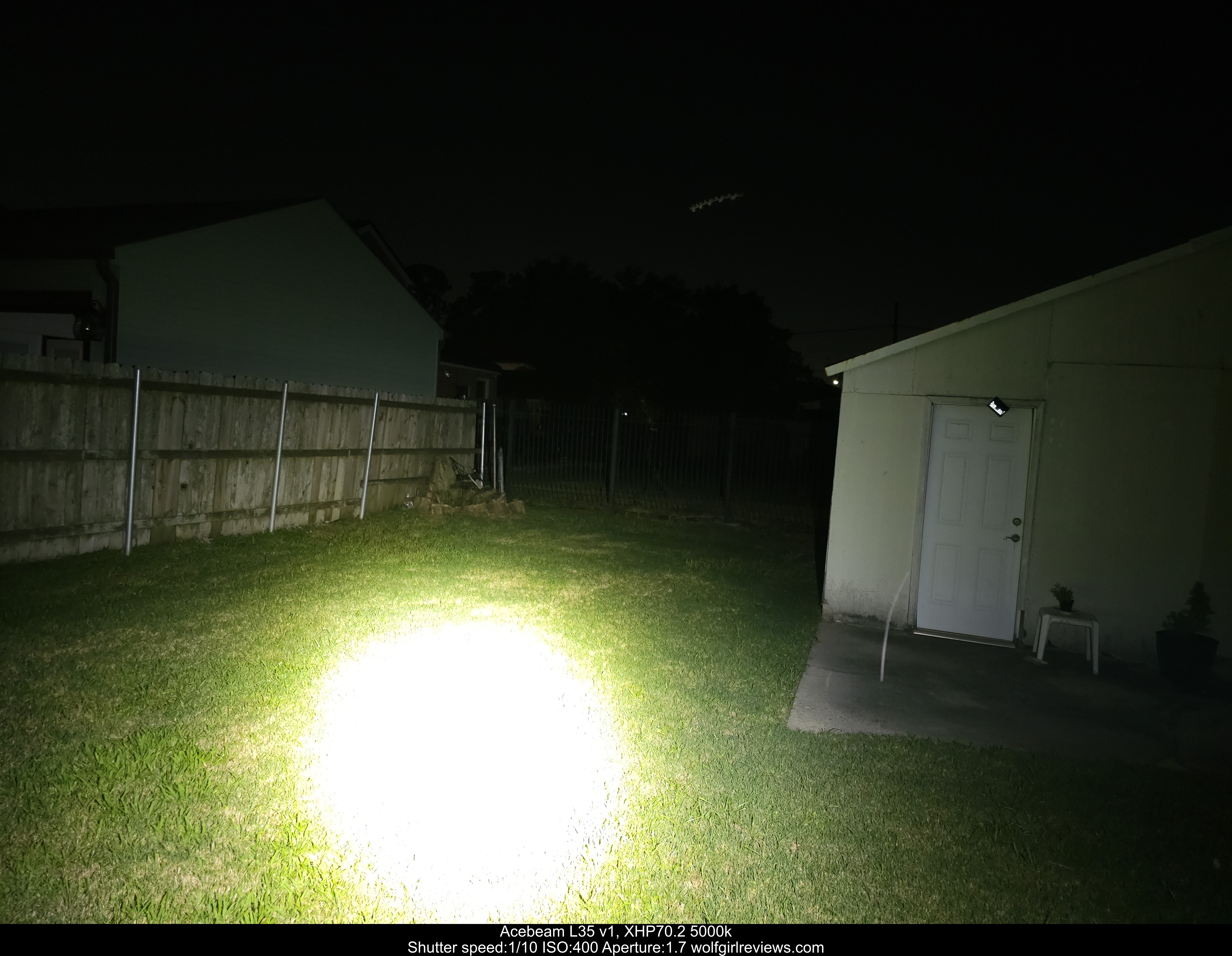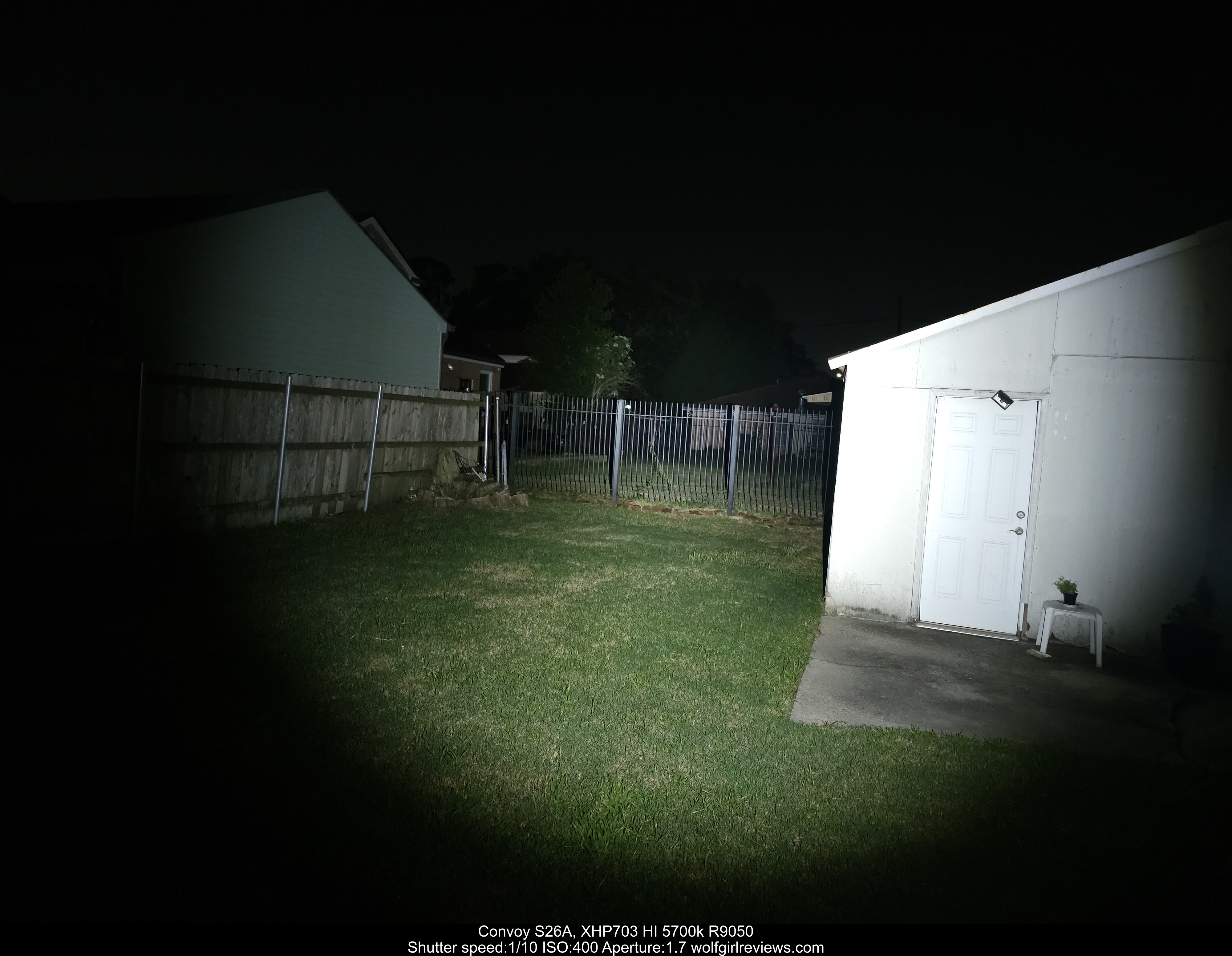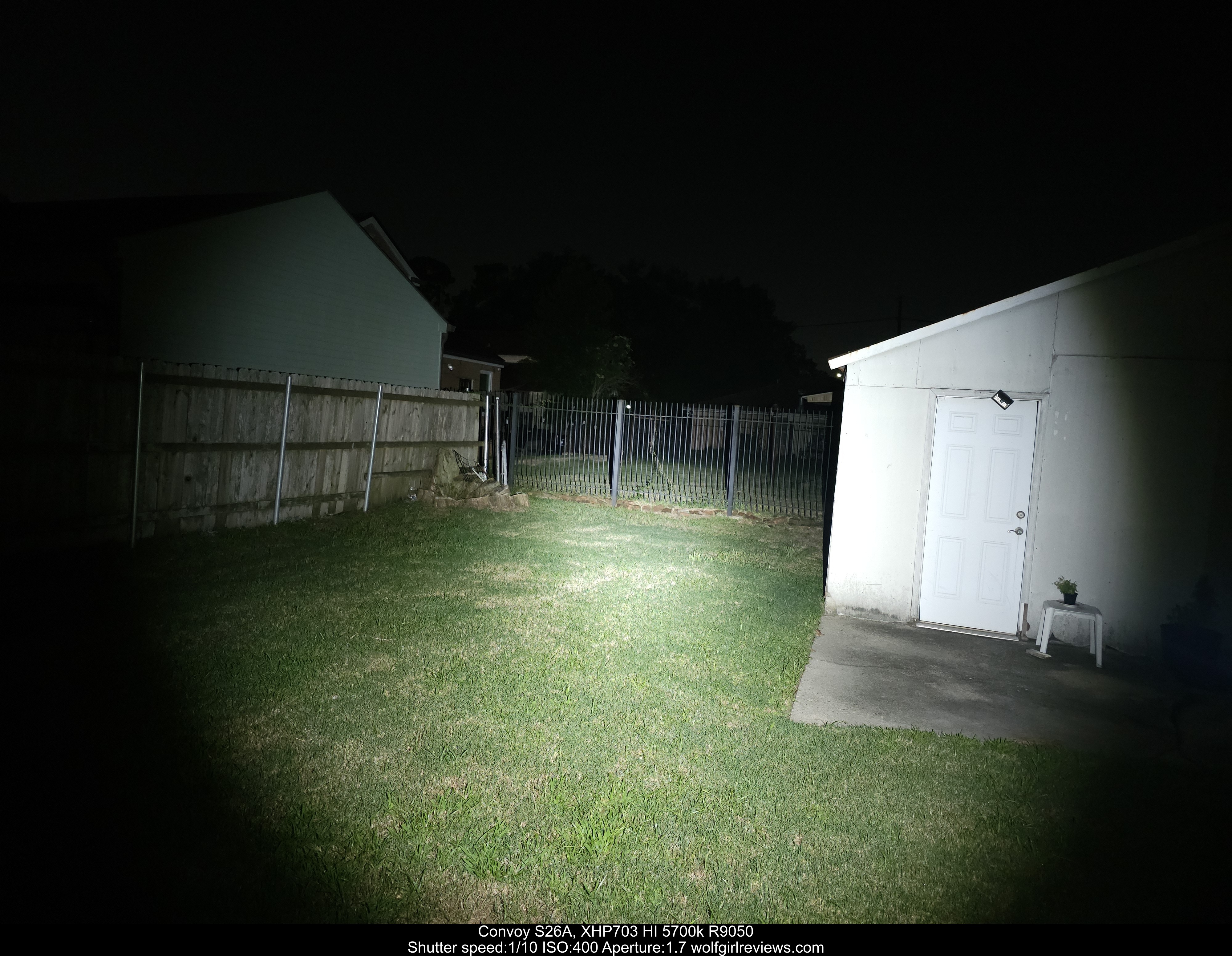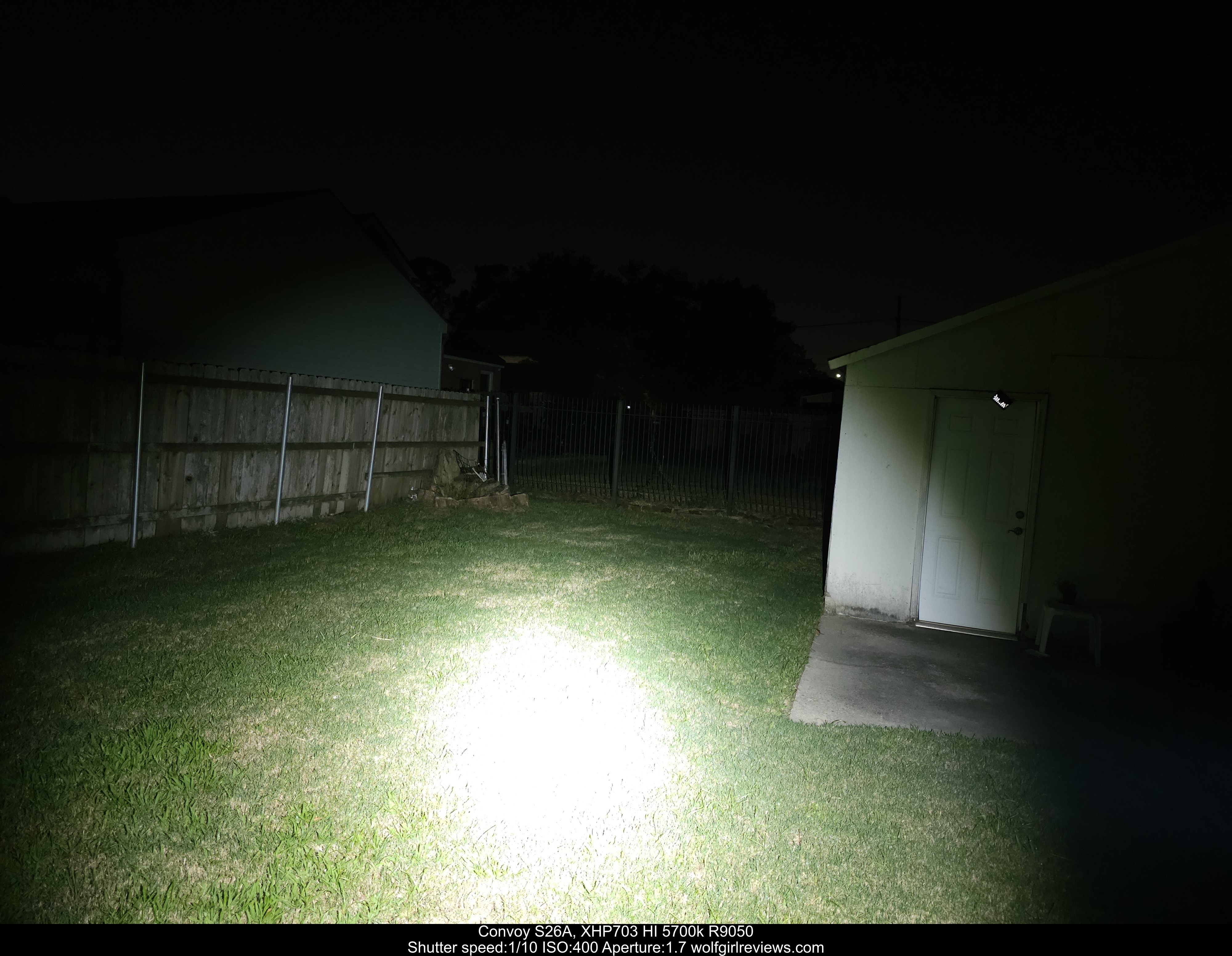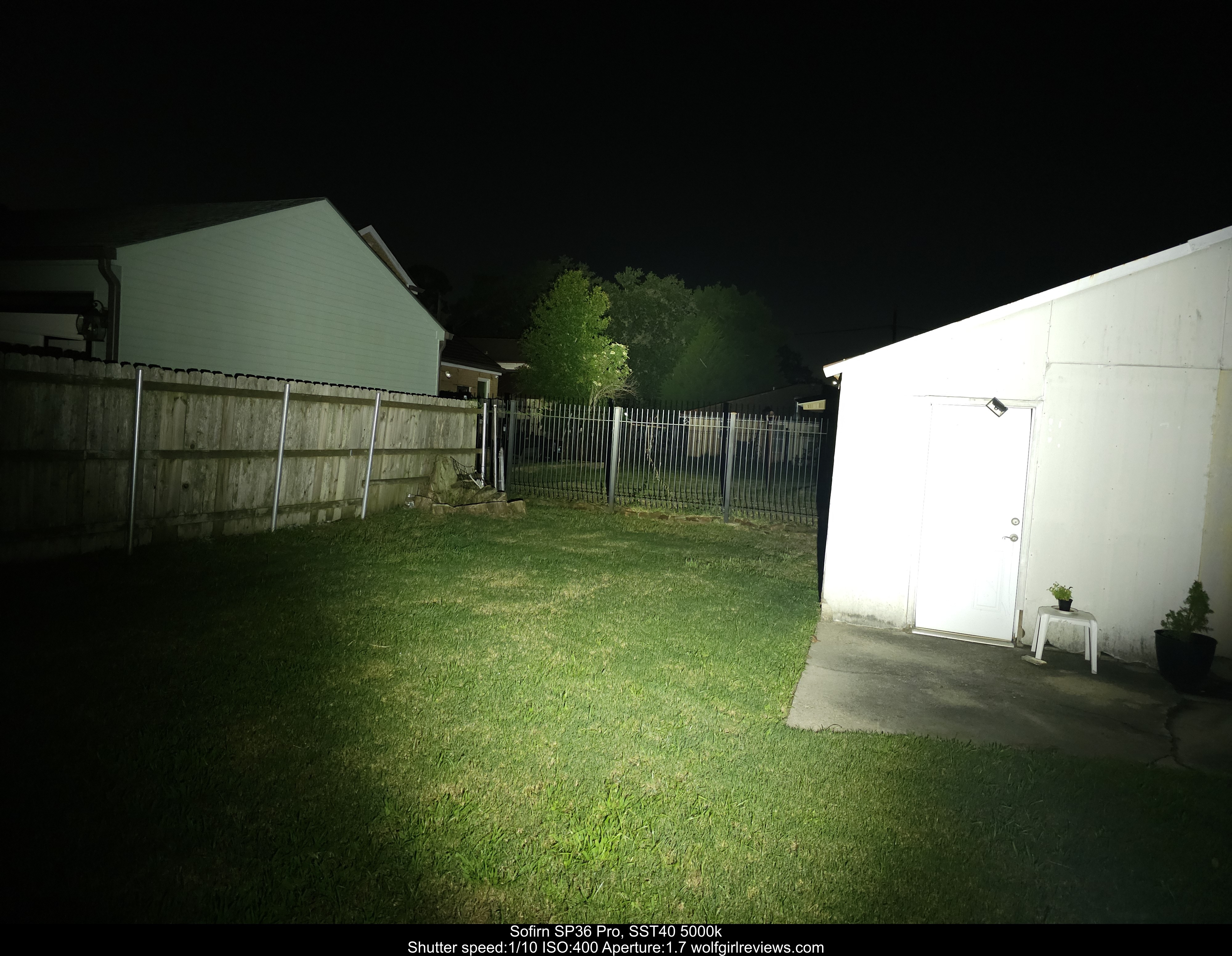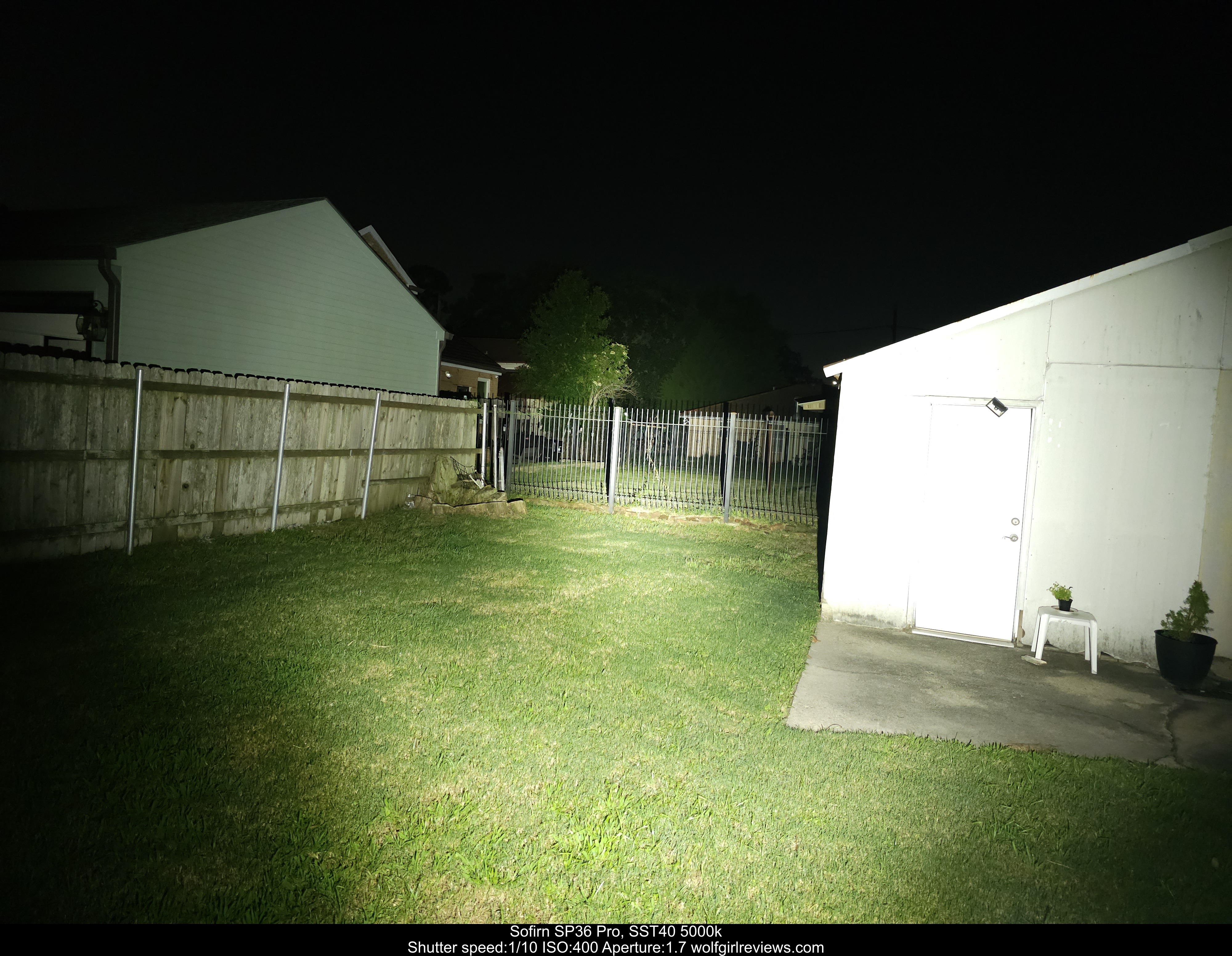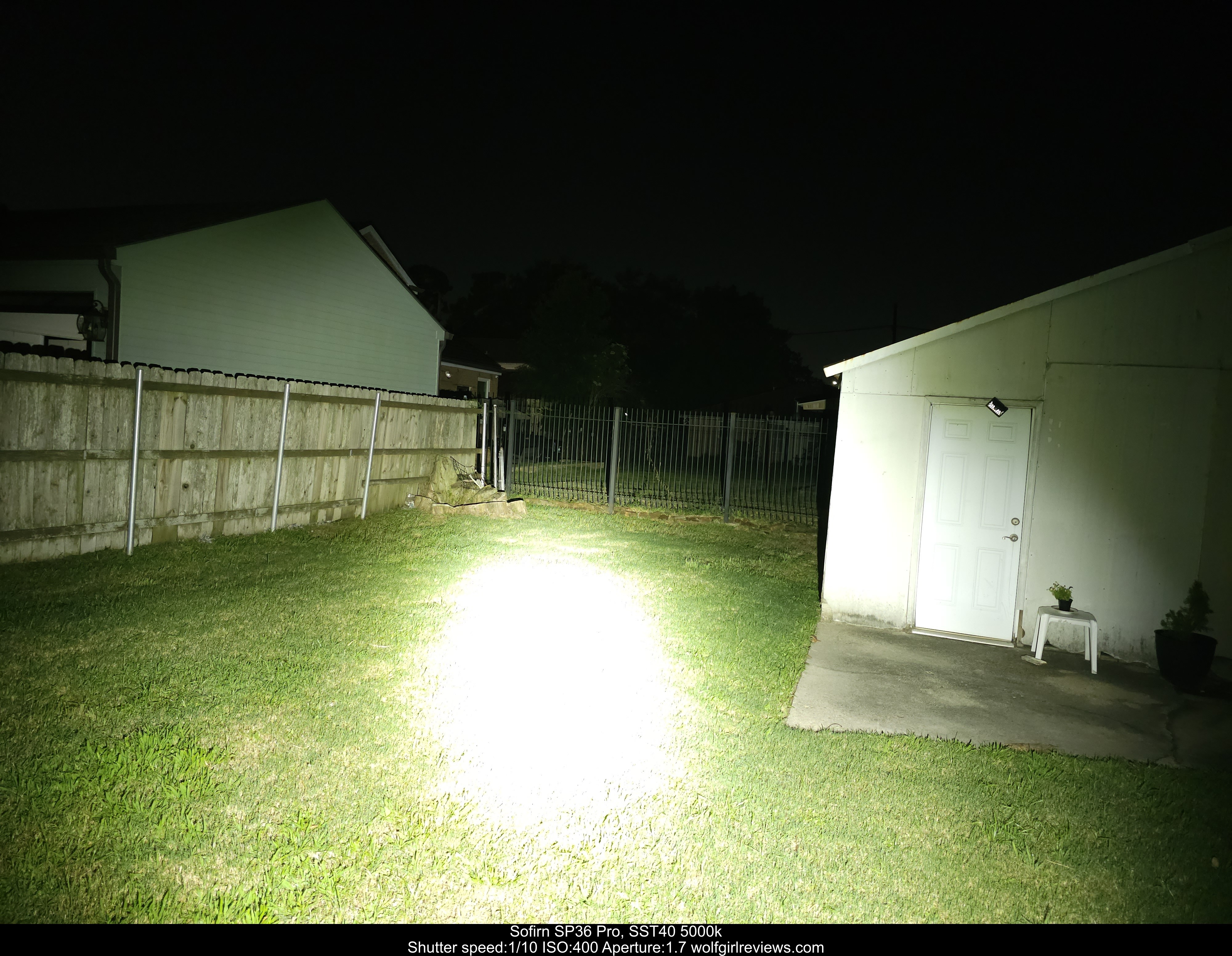"At what point does a tactical EDC light become large enough to be a strategic one instead?"
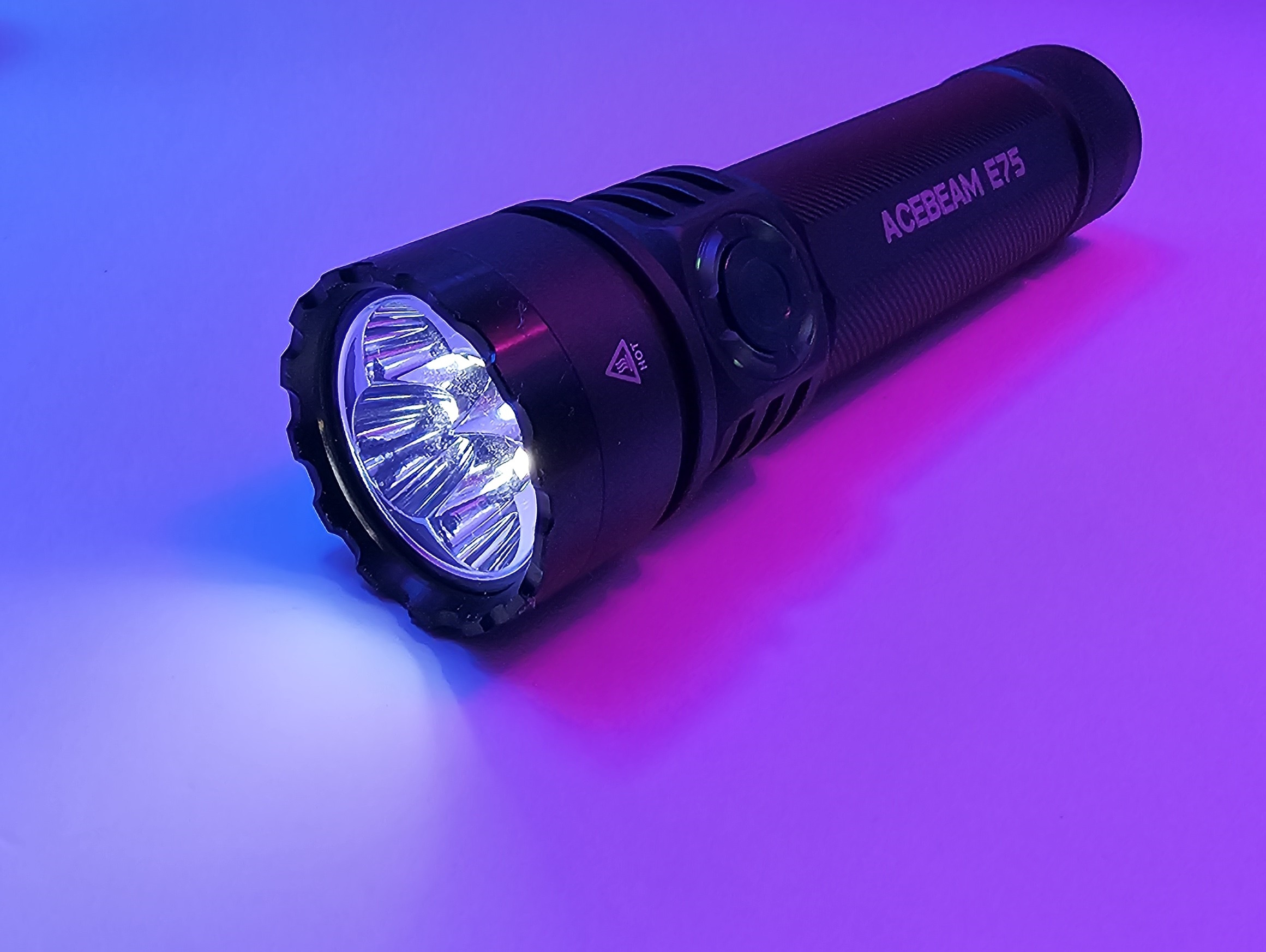 The Acebeam E75 is a large high-power tactical EDC light, powered by a 21700 battery and with an output of up to 4500 lm.
The Acebeam E75 is a large high-power tactical EDC light, powered by a 21700 battery and with an output of up to 4500 lm.
Introduction, Background, and Official Specs
Acebeam have been selling lights for a long time, having recently celebrated their 10th anniversary. Acebeam make lights across the entire spectrum of size from small to large, and are generally best known for high performance tactical lights. The E75 was released in July 2023, replacing the older E70 as Acebeam's flagship large EDC light. The E75 has an efficient boost driver, and is available in two versions, using either high CRI Nichia 519A at 5000k, or high output LatticePower TN3535 at 6500k. Notably, the E75 would generally be considered a flooder, while most tactical EDC lights tend towards the single-emitter thrower form factor. For this review I am reviewing the version with the 6500k LatticePower, which has a spec of 4500 lm, while the 519A version has a spec of 3000 lm.
I opted to review the 6500k version as there are already reviews out there for the 519A version. For performance data on the 519A version, I would recommend the reviews by ZeroAir and TacGriz.
Official specs and test results:
| Parameter | Official Value | Measured |
|---|---|---|
| Output (Turbo) | 4,500 - 1500 lm | 4,550 lm |
| Output (High) | 1,500 lm | 1,587 lm |
| Output (Med 2) | 600 lm | 640 lm |
| Output (Med 1) | 200 lm | 220 lm |
| Output (Low) | 50 lm | 60 lm |
| Output (Moon) | 1 lm | <1 lm |
| Runtime (Turbo) | 1 min + 1 hour, 45 mins | 1 hour, 55 mins ANSI FL1; 2 hours, 40 mins to 0 lm |
| Runtime (High) | 1 hour, 50 mins | 2 hours, 5 mins ANSI FL1; 2 hours, 48 mins to 0 lm |
| Runtime (Med 2) | 4 hours, 40 mins | 5 hours, 23 mins ANSI FL1; 6 hours, 13 mins to 0 lm |
| Runtime (Med 1) | 16 hours | 16 hours, 29 mins |
| Runtime (low) | 2 days, 12 hours | |
| Runtime (moon) | 26 days | |
| Intensity (Turbo) | 16,900 cd (260 m) | 15,495 cd (249 m) |
| Intensity (High) | 5,476 cd (148 m) | 5,741 cd (152 m) |
| Intensity (Med 2) | 2,352 cd (97 m) | 2,898 cd (108 m) |
| Intensity (Med 1) | 1,024 cd (64 m) | |
| IP rating | IP68 (2 m immersion) | |
| Impact resistance | 1.5 m | |
| Weight (without battery) | 145 g | 141 g |
| Weight (with battery) | 217 g | 216 g |
General information:
| Parameter | Value |
|---|---|
| Battery | 21700 |
| Battery check mode | 3 levels |
| Charging | USB-C, rubber flap |
| Emitters | LatticePower TN3535 / Nichia 519A |
| LVP | Yes |
| MSRP | $100 |
| Price (at time of publication) | $100 |
For runtime testing, I give two figures when possible. The ANSI FL1 runtime is calculated by when the light drops below 10% of initial output. I also attempt to run the light past this to find the point where it switches off automatically if possible. Many lights will run at 1 lumen of less for an extended time before powering off, and with these lights I note my observations on when the runtime test was terminated, and may terminate tests at this point as my current measuring setup has a minimum of 1 lumen. For testing of output, my acceptable margin of error is between 5% and 15%, with margin increasing with output.
I was sent this light for free by Acebeam in exchange for a review. I am using an affiliate link for Acebeam products on this article, and am not otherwise compensated for this review, and am giving my honest opinion without holding back on any negative experiences or overstating any positive. I may use affiliate links to Amazon or similar sites for things such as measuring equipment I use, but do not otherwise have any related interest in anything I mention.
First Impressions, Physical Design, and Build Quality
The E75 is packaged in a cardboard retail-style windowed box. Included accessories are a user manual, product certification and warranty cards, a lanyard, USB-C cable, two spare o-rings, and a spare USB port cover (an excellent addition, and something many companies overlook). An Acebeam branded 21700 battery is also included - this is a protected cell, with 5000 mAh capacity and 15A CDR. The E75 is also optionally available with a diffuser, although this was not included with my review sample.
My first impression of the E75 itself is its size. This is a big light, and with the weight to match it. The E75 appears at first glance to be a unibody design*, with the battery tube and head as single piece. The battery tube is covered in very fine diagonal knurling, with four flattened facets with a smooth finish. On the back of the light, opposite the switch, there is a bidirectional pocket clip, attached to the head by two hex screws. There are two slots in the upper part of the pocket clip that could serve as a possible second lanyard attachment point. The clip is of medium firmness, with a springy action on both directions. Underneath the clip, the body tube is smooth, so use of the clip will not cause excessive wear on pockets. The clip is not a deep carry clip, and if the E75 is carried using it, either the entire head or entire tailcap will protrude.
* On closer inspection, the head does appear to be constructed of two separate parts, with a seam visible at the bottom of the uppermost cutout. The two halves seem well glued together and the head design and machining tolerances are consistent enough that to find the seam, in my opinion you have to be looking for it or in general trying to determine how the light is assembled, and it may be easy to not notice.
Directly above the top of the pocket clip is the USB charging port. To replace the rubber port cover, the pocket clip needs to be removed, and retains it in place when fitted. The fitment of the rubber cover is good, somewhat on the tight side and secure enough that I did not have any serious doubts about the E75's water resistance, and when briefly submerged, there was no evidence of any leakage into the port, although I did not test extended immersion. There are three shallow cutouts on each side of the head, then the switch on the top side. This switch is the same one as used in the Acebeam L series, a relatively small and flat metal switch, although on the E75 this switch is additionally surrounded by a dark plastic ring, which contains four red/green aux LEDs, used to show battery and charging status. The switch has relatively shallow travel, and a firm but not stiff click action with positive tactile and audible feedback, and a consistent linear feel and response - multiple clicks are fast and I was not able to cause it to fail to register any clicks.
At the top of the head, the usual "HOT" symbol is on the front beneath the bezel, and a serial number and QR code in the corresponding location on the back. The bezel itself is black, and appears to be coated stainless steel, with a relatively deep lip and serrated top edge. The serrations are not truly sharp, but are noticeable enough when running a finger across the end. The switch is set relatively far back in the head, so my thumb still sits on it comfortably even when bracing the tailcap inside my hand. The lens is set relatively deeply into the head, a feature which when combined with the solid construction of the bezel, ensures the glass lens is well-protected from drops. The lens does not appear to be AR coated. Behind it is a smooth quad reflector, with a relatively deep shape for its overall diameter. In both available emitter options, the E75 used domed LEDs for maximum output, so the depth is probably intended to add some extra throw to the beam.
The battery tube is integrated into the head, and has spiral knurling over much of its surface, other than four flattened areas that are left smooth. The knurling itself is relatively shallow and fine pitched, providing a reasonably grippy surface when combined with the pocket clip and the four flat spots (one of which falls on either side of the tube when held in any orientation). The pocket clip rests against one of the four flattened areas, while the opposite side has markings that say "ACEBEAM E75". The tailcap has matching knurling in a vertical pattern on the sides, and a lanyard loop cut out of one side at the very top - the lanyard does not interfere with tailstanding when attached to this point. On the end of the tailcap are various regulatory marks, a magnet symbol, and "www.acebeam.com". A relatively powerful magnet is inside the tailcap, more than strong enough for the E75 to attach vertically or horizontally to any metal surfaces. Inside the tailcap, the spring is easy to remove and the magnet not glued in place, so it is easy to remove if not needed.
The E75 is available in four different colour finishes - mine is the dark grey. This anodisation feels like HA III, with a very smooth feel in the hand that feels almost slippery on the flattened areas, although the spiral knurling provides more than enough grip that keeping hold of it was not a problem. The finish was consistent and premium-feeling, with no thin spots or blemishes. The overall impression of this finish is most similar to Zebralight's, and appears to use a different process than used on any of my other Acebeams.
Acebeam's warranty is described on their website, and covers their products for 5 years for free repair or replacement, and lifetime coverage for repairs at parts-only cost. Acebeam's customer service is generally responsive.
Size Comparison
I took comparison photos of the E75 with a range of medium to large EDC and tactical lights.
- Emisar D4K
- Noctigon KR4
- Fireflylite E07X Cannon
- Convoy S2+
- Convoy S26A
- Zebralight SC700Fd
- Loop SK01S LEP
- Acebeam L35v1
- Acebeam Terminator M1
- Acebeam Terminator M2
- Wurkkos TD01C
- Wurkkos TD03
- Acebeam E70
- Convoy 3x21E
User Interface
The E75 has a relatively basic E-switch UI, with a few of the specific aspects common to other Acebeam UIs such as the lockout mode and battery indicator, and variants of the same UIs can be found on many different Acebeam models. Overall, the UI is easy to pick up and use - if you've used an Acebeam K75 or X75 you will find it familiar, as well as the L series' sideswitch.
1C switches the E75 on and off, with 1H cycling through four brightness levels, in addition to turbo on 2C and moonlight mode (at 1 lumen, this mode is on the high side for a moonlight mode but still low enough to qualify as one in my opinion) on 1H. Strobe is on 3C, and there is a lockout mode accessible by holding the switch for a relatively long time (around 5 seconds), after which the main emitters blink and the E75 remains on moon mode until the switch is released, at which point it enters lockout mode. In lockout mode, clicking the switch will cause the switch LEDs to blink in alternating red and green, and when holding for 5 seconds again, unlocking to moonlight mode. There is no way to unlock directly to a higher mode, something I find a surprising omission in a light with what in general is a tactical-oriented design (and a feature I use often in Anduril) - although it is not much of an additional delay to use 2C to get to turbo once the light is unlocked, it can feel frustrating when waiting 5 seconds to unlock - while the E75 is certainly a light I would be happy to rely on for defensive purposes, I would not feel as comfortable if carrying it locked out. In addition, there is no way to access any kind of momentary low mode when locked - you always have to fully unlock the light first.
Other than communicating the lockout mode status, the switch LEDs are used for battery and charging status. The switch LEDs are always on when the main emitters are, and show the battery status as one of three levels - green for over 20%, red for 10-20%, and flashing red for below 20%. This is the common battery indicator found on many Acebeam lights, although I personally feel the warning thresholds are set somewhat too low - the E75 does have excellent regulation even on a low battery, but it is possible to end up caught out if you don't charge or check your battery regularly. Unfortunately, there is not any more detailed battery check mode - the E75 was clearly designed to be charged regularly with the built in USB port, but I still think a little extra warning of the battery status would be helpful.
| State | Action | Result |
|---|---|---|
| Off | 1C | On (mode memory) |
| Off | 2C | On (turbo) |
| Off | 3C | Strobe |
| Off | 1H | Moon |
| On | 1C | Off |
| On | 2C | Turbo |
| On | 1H | Cycle output levels |
| Off | 5+ sec hold | Lockout |
| Lockout | 5+ sec hold | Unlock to moon |
| What it gets right | What it gets wrong |
|---|---|
| Direct shortcuts to turbo and moonlight | Battery indicator is not of much use other than to warn of impending critical battery; no discrete battery check mode with higher resolution |
| In general a well-rounded UI - easy to pick up and use, and following generally popular standards for UI design | Lockout mode is very slow to enter and exit |
| Steps are reasonably consistent in spacing and make for a relatively linear perceptual increase with each step | No momentary moon mode when locked - have to unlock to use the light at all |
Using the Light
The E75 is a large light, and definitely has a presence in a pocket or bag. Some people may find the E75 too large to EDC; for me it is right on the borderline, but for some people the E75 is potentially more of a jacket pocket or "around the house" light rather than EDC (obligatory reminder that a purse allows for a lot more and larger EDC items than pockets). When not testing review lights, I normally carry either an Emisar D4K or a Fireflylite E07X Cannon for a high output flooder, and the E75 definitely has more presence than either - this is definitely not a light you are likely to forget you're carrying. Notably, it is very long - I personally am less concerned with diameter and more with length when it comes to how easy I find a light to carry, but the E75 has a relatively small diameter for its performance, sitting between the D4K and E07X. On the other hand, it is longer than either to the point of being comparable to various pocketable LEPs, so if length isn't a limitation then the E75 lets you pack a lot of sustained performance into a small diameter.
If you have large pockets, the E75's pocket clip does a good job of keeping it in place - the stiffness in particular feels perfect, holding the light securely while not being difficult to clip and unclip, and with a smooth surface underneath the clip for the entire battery tube, this is definitely not much of a pocket shredder. One reservation I do have is that I sometimes feel uncomfortable carrying it while not locked out - the switch is not the easiest to accidentally press, but it can happen, and on turbo the E75 puts out a lot of heat very quickly. The magnet in the tailcap may interfere with pocket carry for some, but the spring inside the tailcap is easily removed with a pair of small pliers, at which point the magnet is not glued and will drop out. I very much appreciate this attention to detail as someone who often carries lights near other items that could be affected by magnets.
The E75 has very comfortable ergonomics, with the spiral knurling on the battery tube providing excellent grip both with bare hands and with gloves on, although extremely thick and heavy gloves may pose more of a problem, in which case use of the lanyard might be appropriate. I found the pocket clip on the underside enhances handling and still sits flat against my hand when gripped tightly, and I found holding it with one of the flat sides facing in to be just as easy to handle as long as you do not need to change modes.
The switch is set somewhat far back on the head with around 25mm of protruding head and bezel above the user's thumb - this, when combined with the E75's weight and build quality, definitely gives it a tactical feel, and I found it easy to brace the tailcap in my hand while keeping my thumb on the switch. The lightly serrated bezel lets you see if you have put the light down while it is still on, something I appreciate as a design touch, while the edges of the serrations are not truly sharp, but enough to concentrate some significant force. The E75 is a light I would feel unsure about taking through airport security - it may or may not be fine, so whether you are allowed through with it is entirely in the hands of a random person. On the other hand, the serrations plus the E75's high output and general weight and sturdiness make this feel like an excellent defensive light, and it is certainly one I would feel happy to have in my hand when walking alone at night.
The beam tends towards balanced, due to the combination of a relatively deep smooth reflector, and domed LEDs optimised more for output than throw. The beam has a relatively wide and smooth hotspot, and a noticeable flower petal pattern in the edges of the spill. There is a noticeable yellow corona of tint shift around the hotspot when used indoors even at a distance, although it is harder to see outside.
The moonlight mode is somewhat on the high side at around 1 lumen, but still low enough to be classed as moon. Overall, I found the modes to be well spaced with a relatively linear perceptual difference between each step from low, including from high to turbo. Usually around the house I found medium 1/2 to be useful, although when walking I tend to use high and turbo more when some distance is needed.
The E75 has a relatively efficient boost driver, achieving high performance even as the battery drops, and output drop on high modes was mostly due to thermal throttling. On turbo, the E75 heated up to a maximum surface temperature of 54.4 degrees C (130 F), after 2 minutes and 50 seconds, before stabilising at 50 degrees. Overall, thermal performance is good, with relatively slow heating for the output figures.
Driver and Emitters
The Acebeam E75 uses a boost driver - Acebeam are well known for their high power boost drivers in their medium to large lights and the E75 is no exception here, with output not that far off some of the most powerful FET drivers in the 1x21700 category. The emitters themselves are standard 3535 emitters, either the high CRI Nichia 519A, or the LatticePower TN3535 for the high output cool white version. These are both domed emitters optimised for flood - when combined with the relatively deep reflector, this gives a balanced beam overall, with some bias towards flood but enough range on high settings for general use - overall throw is comparable to other high output EDC lights of a similar size. Both emitter options use the same optic and have some tint shift, with a noticeable yellow corona around the hotspot, although this seems to be more visible with the 6500k than the 519A version. This is mostly visible indoors against a wall and I did not find particularly noticeable outside. The hotspot itself is wide, smooth, and circular with no obvious artifacts, and the spill follows the typical pattern of multi-emitter reflectors, with a flower petal effect at the edge of the beam.
DUV is positive at all output levels, particularly moon and low, although the output does move closer to neutral on high and turbo. The 6500k version of the E75 is designed first and foremost for maximum output - for neutral or negative DUV, the 519A version would be the version of choice here - that said, the overall tint was tolerable for outdoor use and is far from the greenest LED light I own. CRI is low at 68-71 depending on ramp level.
I measured the E75's CCT and CRI with a Colormunki Photo and ArgyllCMS.
CRI and tint
Power and Charging
The E75 includes an Acebeam-branded protected 21700 cell rated at 5000 mAh and 15A. This is the higher rated of the two 21700 cells Acebeam commonly uses, without the USB port. The E75 has dual springs and also accepts standard unprotected 21700 batteries. The driver has low-voltage protection so the use of a protected cell isn't strictly required, and any non-proprietary 21700 cell of at least 15A CDR should work fine in the E75.
There is no power bank mode - when I connected a phone to the E75 with a C-C cable, this resulted in the E75 drawing power from the phone to charge.
Charging data was collected using rd-usb with an RDTech TC66C (info, Amazon (US).
A charging rate of 1.5A is slightly on the high side for daily use with cheaper batteries, but within acceptable limits for high quality cells, and Acebeam's included cells have never been a problem for me or anyone else I have noticed. Charging terminated at 4.20V correctly.
Moddability and Repairability
The E75's bezel is secured with glue or threadlocker, but can be removed with some effort. Once removed, the lens can be changed, and the reflector removed to access the emitters. Some people have dedomed the emitters of the 519A version, and different emitters could be reflowed onto the MCPCB. As previously mentioned, the magnet is easily removable from the tailcap for a magnet-free option, or alternatively swapped with an even more powerful one (although I found the stock magnet to be about right for my own preference). I must also congratulate Acebeam on excellent design for making the charge port cover easy to replace and including a spare, as charging ports are sometimes divisive as a question of convenience, and two of the most common reasons are that the cover will eventually fail, and a poorly fitted cover can compromise water/dust resistance, but Acebeam's designers seem to have considered both and this is overall an excellent charging cover flap, one of the best rubber flaps I have seen and only clearly losing out to Fireflylite's metal flap. Other than that, the internals of the head are clearly not designed to be accessible.
Performance
All lumen measurements taken using a TKLamp TK2303D. This is a project that I worked with TKLamp on the development of, and I received mine at a discounted rate as part of a BLF/Reddit group buy of the initial production run. At the time of this test, I did not have the calibration lamp to calibrate my tester (this is an issue specific to the initial run where an incorrect calibration value was used - any new orders will be pre-calibrated). To work around this limitation, I found the E75's low and medium modes were stable and repeatable enough to be used for calibration, so I measured those on my 4.5 inch Texas Ace lumen tube and used those readings to calibrate the sphere. Candela measurements were performed indoors at a distance of 3m, using a UNI-T UT383BT datalogging luxmeter.
Output and Throw
| Mode | Spec | Peak output | Output after 30s | Output after 1 minute | Output after 90s | Output after 5 minutes | Output after 15 minutes |
|---|---|---|---|---|---|---|---|
| Turbo | 4,500 lm | 4,550 lm | 4,394 lm | 4,263 lm | 3,882 lm | 1,495 lm | 1,488 lm |
| High | 1,500 lm | 1,587 lm | 1,581 lm | 1,574 lm | 1,567 lm | 1,542 lm | 1,500 lm |
| Medium 2 | 600 lm | 640 lm | 640 lm | 639 lm | 639 lm | 636 lm | 632 lm |
| Medium 1 | 200 lm | 220 lm | 220 lm | 220 lm | 220 lm | 220 lm | 220 lm |
| Mode | Spec | Peak candela | Candela after 30s | Candela after 1 minute | Candela after 5 minutes |
|---|---|---|---|---|---|
| Turbo | 16,900 cd | 15,495 cd | 15,167 cd | 14,998 cd | 6,485 cd |
| High | 5,476 cd | 5,741 cd | 5,723 cd | 5,714 cd | 5,633 cd |
| Med 2 | 2,352 cd | 2,898 cd | 2,898 cd | 2,898 cd | 2,889 cd |
Runtime
| Mode | Spec | Runtime |
|---|---|---|
| Turbo | 1 hour, 46 mins | 1 hour, 55 mins ANSI FL1; 2 hours, 40 mins to 0 lm |
| High | 1 hour, 50 mins | 2 hours, 5 mins ANSI FL1; 2 hours, 48 mins to 0 lm |
| Medium 2 | 4 hours, 40 mins | 5 hours, 23 mins ANSI FL1; 6 hours, 13 mins to 0 lm |
| Medium 1 | 16 hours | 16 hours, 29 mins (both) |
Performance Overview
The E75 meets specs within a small margin of error on turbo, and somewhat exceeds them on the lower modes. Runtime was higher than spec overall, notably exceeding by 43 minutes for the ANSI FL1 runtime on medium 2. In general, candela specs were within an acceptable margin of error of my measuring equipment, reading slightly below on turbo but above on lower modes. Overall, the E75 has excellent regulated output, with output remaining almost perfectly flat in low and medium modes, and after thermal regulation kicks in on high and turbo. Higher modes have one distinct step down to a lower output of around 50 lm before switching off entirely.
Beamshots
| Light | Emitters | Notes |
|---|---|---|
| Emisar D4K | W2 6000k | Tested at 4,800 lm |
| Fireflylite E07X Cannon | XP-L HI 6500k | Tested at 5,600 lm |
| Convoy S26A | XHP70.3 HI 5700k R9050 | Tested at 2,550 lm |
| Emisar DT8K | W2 6000k | Tested at 7,200 lm |
| Acebeam L35v1 | XHP70.2 5000k | Tested at 4,300 lm |
| Sofirn SP36 Pro | LH351D 5000k | Tested at 5,800 lm |
| Convoy 3x21E | 519A 5700k | Tested at 12,000 lm |
E75
Comparison Beamshots
Competitors
Emisar D4K: The enthusiast option. Cheaper and slightly more compact than the E75, huge selection of LEDs, no built-in charging. Outperforms the 6500k E75 with W2 or SST20 and the 519A version of the E75 with 519A, but will drop off in output faster and harder, although a reasonably close thermally sustainable level can be achieved. Anduril and the E75's UI are very different and it's a matter of whether you prefer tactical or enthusiast-oriented design. Tailcap magnet optional.
Fireflylite E07X Cannon: Similar to the D4K, another enthusiast option, but closer in size and price to the E75 and with a higher turbo output, and wider head to accommodate 7 LEDs. A few emitter options including high output and high CRI, but not as many as the D4K, and available emitter options have changed several times in the past. Has a high efficiency buck driver so has output stability more comparable to the E75's, and also includes built-in USB charging. Tailcap magnet optional.
Wuben X1: Similar length, but flat and wider than the E75. Similar UI, higher price point, Higher turbo output and stable regulated output, active fan cooling, built in USB-C charging. Batteries are technically replaceable but needs disassembly. No tailcap magnet.
Wurkkos TS22/TS26: Cheaper price point, comparable output. The TS22 and TS26S use a simple UI that is broadly similar to the E75's, while the TS26 is an upcoming version that uses Anduril. USB-C charging on all versions.
Acebeam L35: A larger light, more throw and flood from a larger optic. Not really EDC sized, more of a jacket pocket light and a true tactical light rather than EDC. Technically slightly lower turbo output, but better sustained output. USB-C charging on battery instead of body. User interface is essentially the same as the E75, but with the addition of a large tailswitch that always selects turbo (and, rarely among dual side/tail switch lights, can also be electronically locked out).
Zebralight SC700: Unique-if-divisive user interface, comparable build quality and durability to Acebeam. High efficiency, lower turbo output but comparable sustained. Available in both floody and throwier versions (SC700fd and SC700d HI, respectively). Has a neutral CCT at 5000k rather than the E75's 6500k.
This section does not list all possible alternatives, is subject to my own interest and views on listed lights, and is primarily intended to give a general overview. A light not being included here does not mean it should not be considered a viable alternative.
Potential Improvements
- Lockout mode: A lockout mode on 4C would fit the UI well and has a huge degree of commonality with many popular lights, while making medium and high modes much quicker to access from lockout.
- Bezel: An unglued bezel and an option to swap to a less aggressive bezel would be a nice benefit for anyone thinking of flying with the E75, as while I wouldn't definitely expect to get stopped by security, I would also not expect it to definitely be fine.
- Battery indicator: The E75 can discharge its battery as low as 20% before the user gets a warning. While the USB port does make topping up the battery feasible when around power, if out and about with nowhere to charge, then a more granular indication of battery status would be helpful.
Final Thoughts and Score
| Category | Score | Comments |
|---|---|---|
| Looks | 8/10 | As long as you like the tactical look, the E75 is a great looking light. The finish is flawless, the knurling is thoughtfully designed, and the glossy bezel and clip make a nice contrast with the anodisation. Markings on the body where they are most likely to be seen are relatively minimal, although the tailcap markings are somewhat obtrusive. The aggressive bezel may not be to everyone's taste, but it is still subtle when compared to some lights. |
| Quality | 9/10 | Everything feels high quality, and the surface finish is durable and consistent. the pocket clip has just the right amount of flex, easy to use without worry of bending it, and not stiff enough to be inconvenient. The tailcap threads are smooth and tight, although mine did arrive with less lubricant than I prefer, so I cleaned them and relubed with Nyogel 760G as I do with many of my lights, but even without this they were smooth and didn't have any hint of roughness. Most likely, many people will not be removing the tailcap often or at all other than to remove the battery insulator on first receiving the light, due to the USB charging, so this is less of an issue than on lights without USB. The USB port cover itself feels like reasonably good quality rubber, and the replaceable design and included spare is an amazing touch that I think more light makers should consider. I am also very happy that the tailcap magnet is easily removable using only a pair of small pliers without needing to do complex disassembly or ungluing parts. The E75 has the usual 5 year warranty from Acebeam. |
| Performance (absolute) | 8/10 | 4500 lm is in the upper range of 1x21700 quads, and this is one of the top performing tactical lights in this category, with only enthusiast "hotrod" lights generally performing higher. The E75 is generally a flooder, but throw is still respectable for domed emitters. |
| Performance (sustained) | 9/10 | The E75 has an excellent sustained output, easily challenging the common favourites in the 1x21700 size class such as the Zebralight SC700 series and Fireflylite's buck driver models. Regulation is very consistent, with output rarely dropping with battery voltage sag and most stepdowns being due to thermal regulation. |
| User interface | 7/10 | While I tend to prefer enthusiast lights with Anduril for configuration options and features, there is nothing strictly wrong with the E75's user interface, and it nails all the basics of what make a good user interface. Strobe on 3C is not my favourite feature, but it is less annoying due to the lower risk of accidentally entering strobe when lockout is not on 4C, one of the reasons I generally dislike 3C strobe. That said, I am not a fan of the E75's lockout mode, which is extremely slow to enter and exit, and there is no momentary moon or low mode. The lack of an ability to unlock directly to turbo was also something I found myself missing relatively soon, and in general I felt discouraged from locking the E75 out. If you tend to prefer tailcap lockout this is less of a problem. |
| Moddability and repairability | 5/10 | The emitters can be accessed via the bezel for a swap or to dedome the 519A version. The head seems extremely difficult to disassemble further - the two pieces seem to be very tightly together, possibly threaded and using some strong threadlocker. The magnet in the tailcap can be easily removed. Acebeam do have a reputation as being unwilling to sell parts for owners to repair or modify their own lights outside of warranty coverage, but warranty service is generally done without problems. |
| Practicality | 8/10 | The E75 is probably too large for some people's preferences for a true EDC light, but is easy to carry in a bag or jacket pocket, and makes an excellent around-the-house light as well as for use in activities such as camping or hiking where size and weight are of less concern than an EDC light. The E75 excels at runtime and maintaining a stable output until the battery is almost empty, although with the USB port and the relative lack of information on the battery level, it is clearly intended to be kept mostly in a charged state. It is worth noting that the stock Acebeam battery includes a protection circuit, so will have a higher self-discharge than an unprotected battery, although I have found that in general the specific protection circuits Acebeam use are at least reasonable here when compared to some other protected cells I own, and I would expect a standby time of at least a few months with usable battery capacity remaining even with the passive drain from the e-switch. |
| Value | 8/10 | The E75 has an MSRP of $100, which is in line with most high performance 1x21700 lights. Boost drivers tend to be more expensive than other types, with higher component counts and prices, and combined with the excellent machining and general attention to detail of the design as well as the long warranty period, the E75 overall offers very good value. |
| Overall | 8/10 | If you like your EDC on the large and tactical sides, the E75 is an excellent light. The space it competes in is one of the more crowded in the market, but the E75 justifies its price point with its performance and build quality. The user interface may feel limiting to some enthusiasts, but overall this is an excellent light for general purpose use. |
The E75 is available from acebeam.com.
My thanks to Jessie from Acebeam for understanding when this review was delayed due to various things happening in my life including activism, work, and illness all getting in the way at different times. I am currently still dealing with some health problems, but should have the next review out much sooner than the gap to this one.
As always, feedback is welcome - I am active on BLF or Reddit, both on /r/flashlight and other specific subreddits, and have started my own subreddit for review content at /r/WolfgirlReviews.
>> Home



















